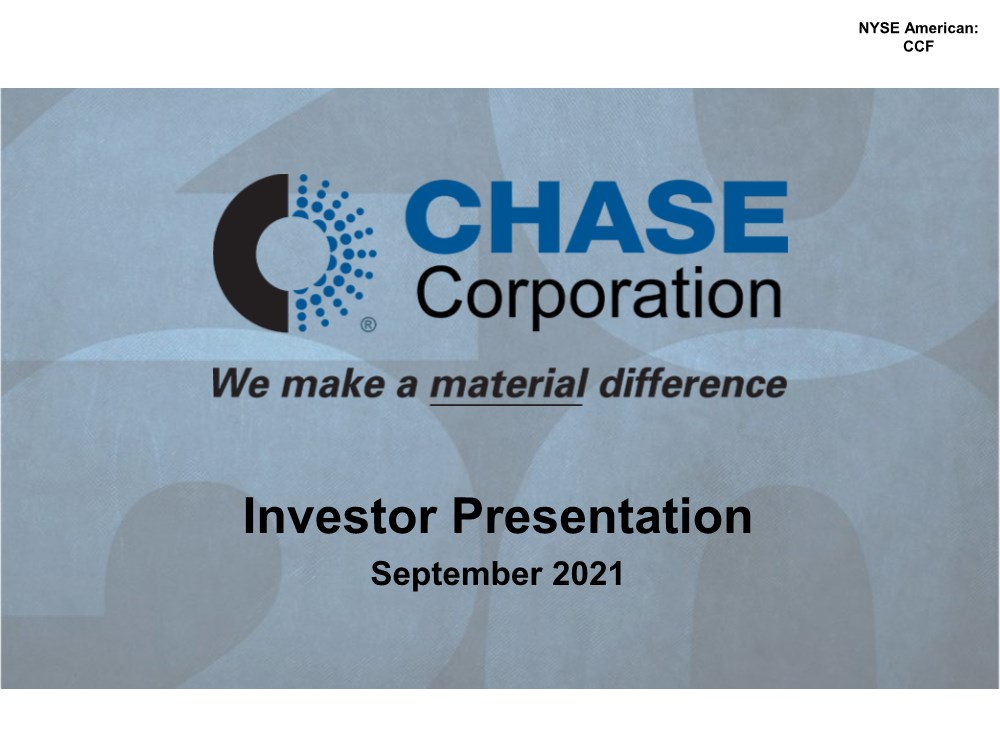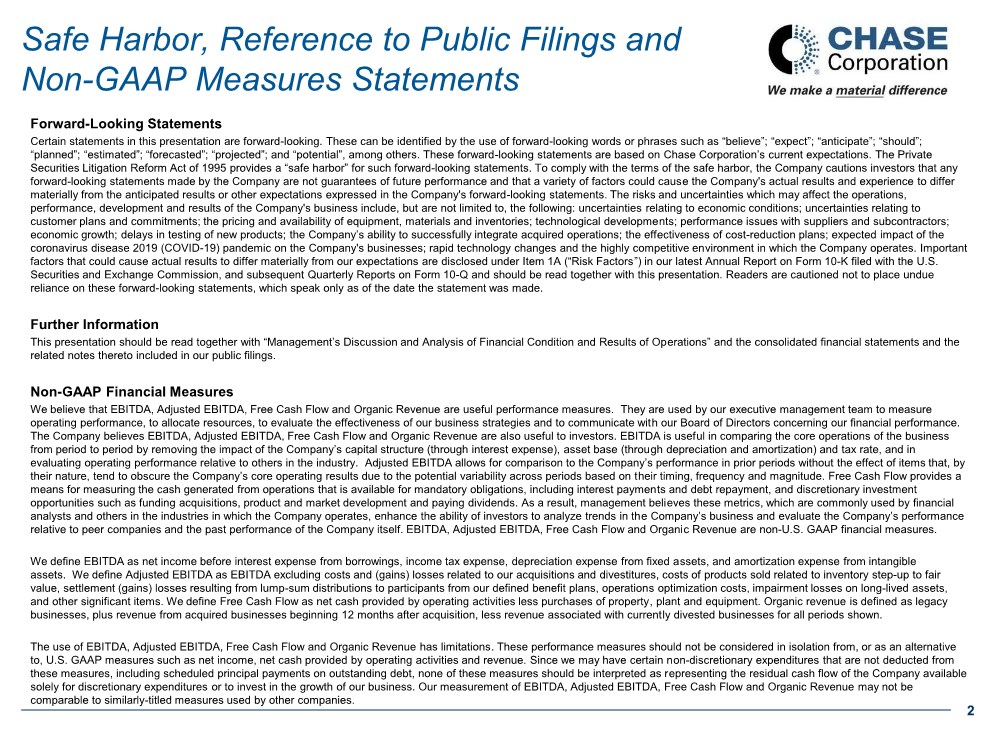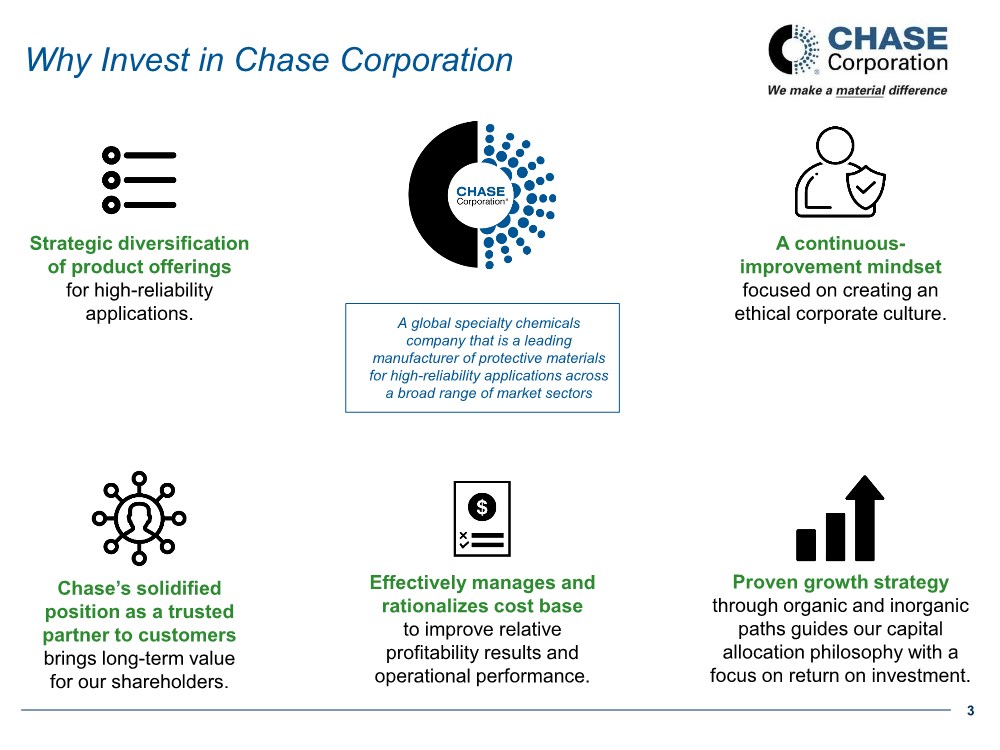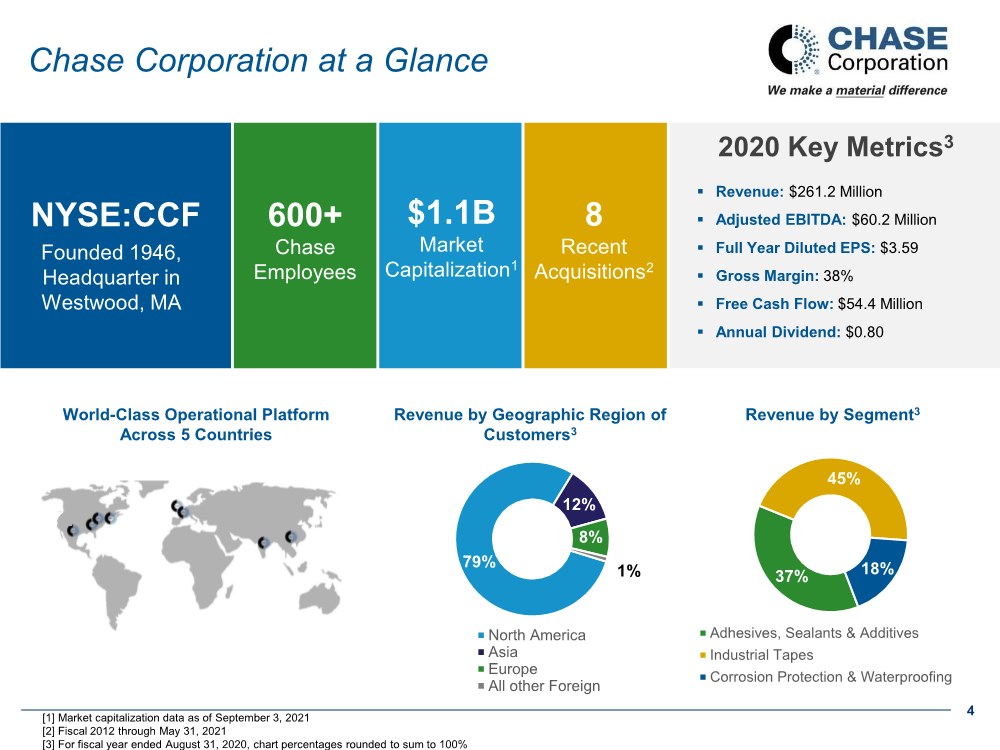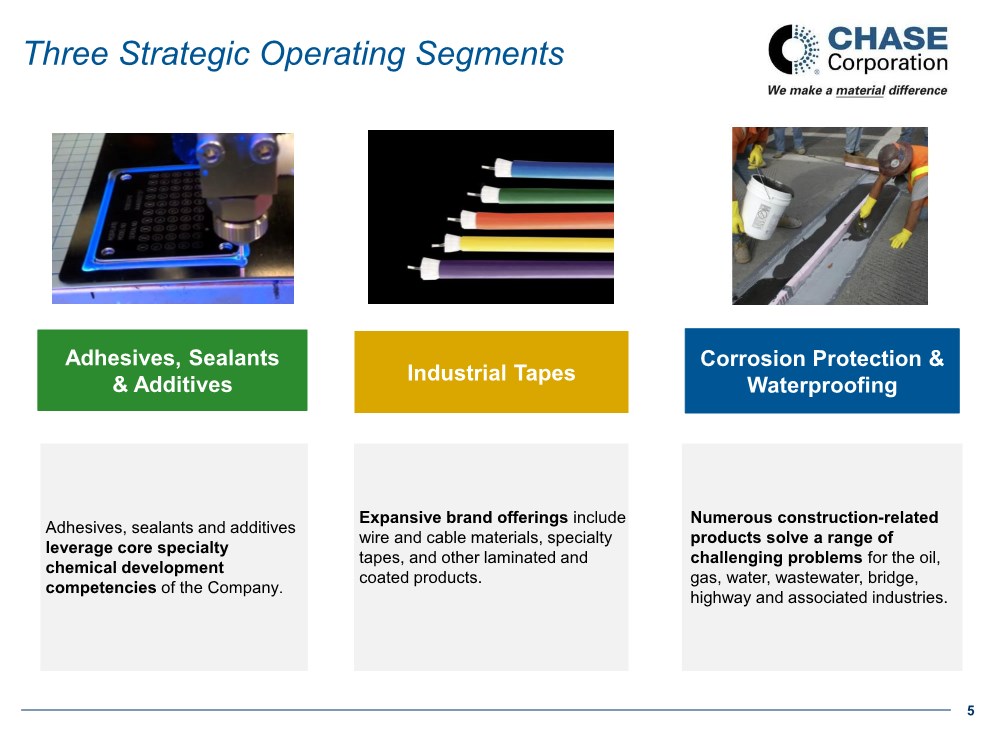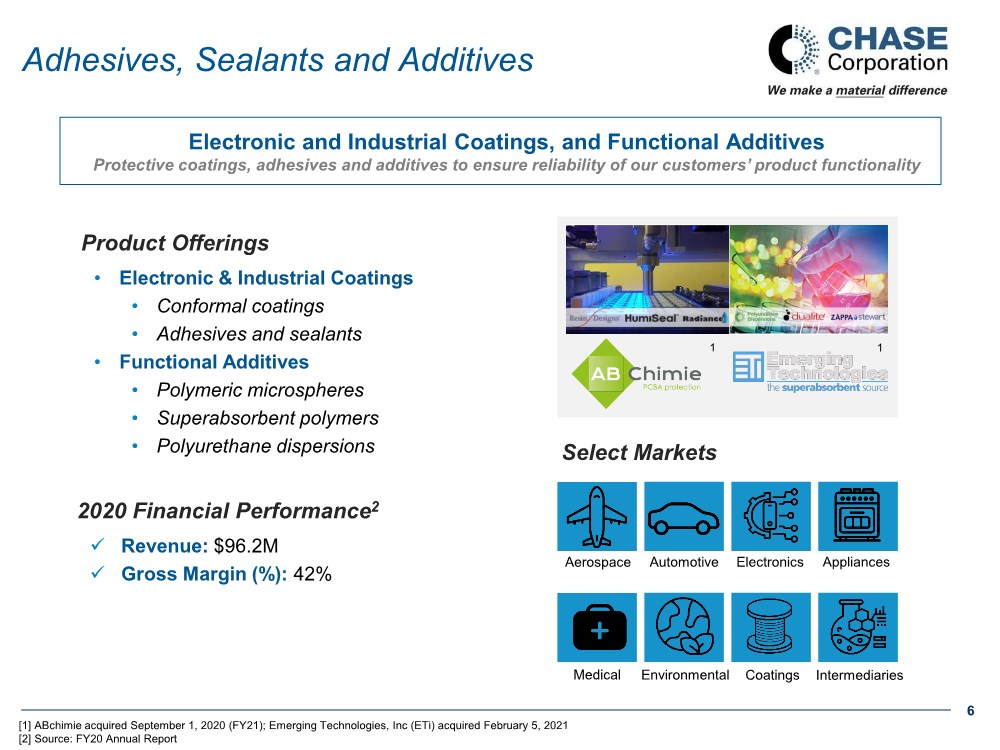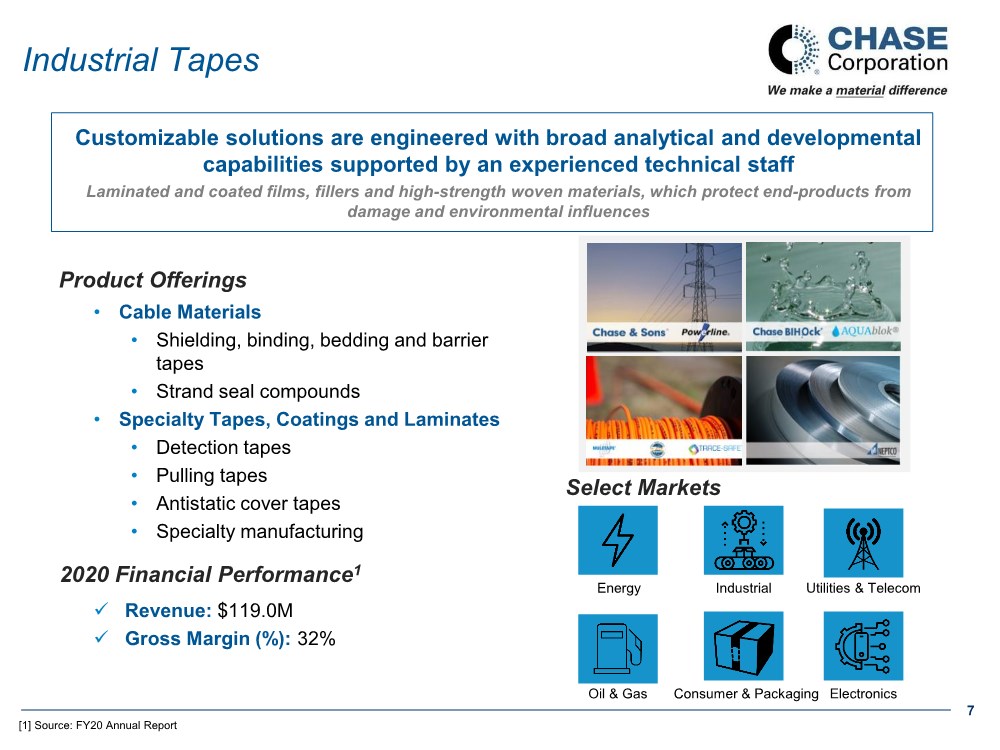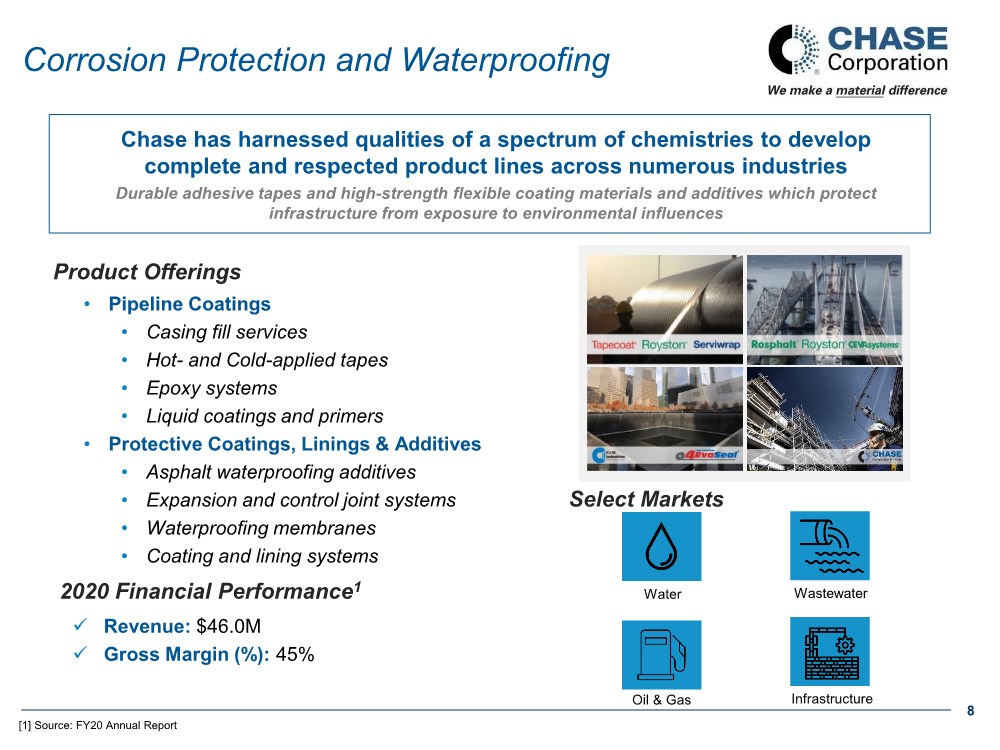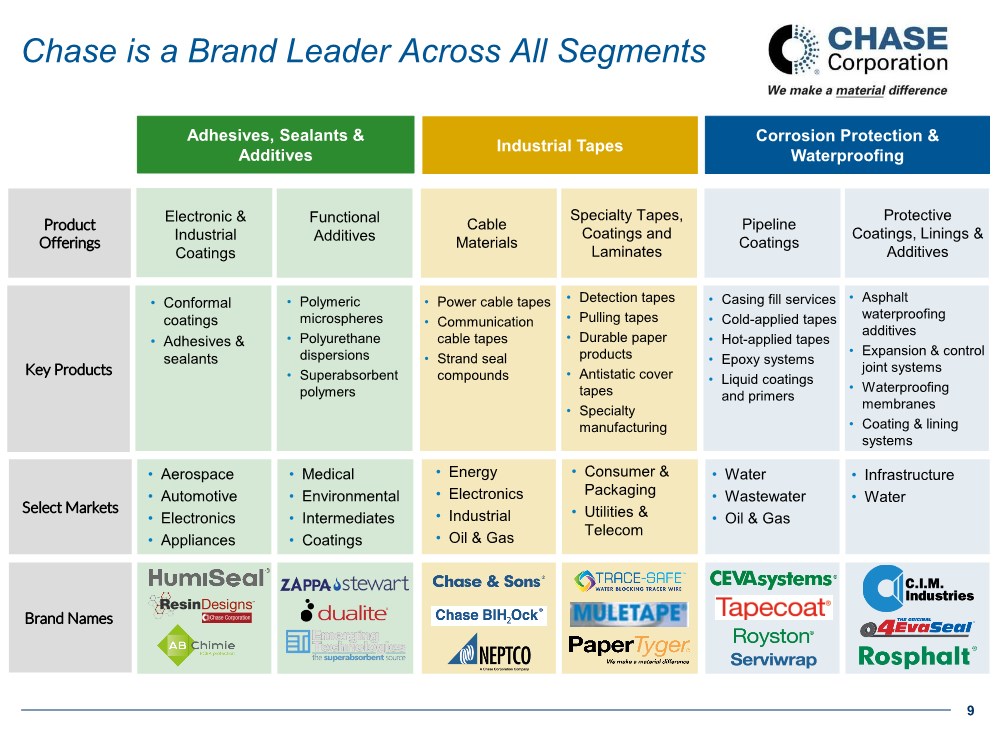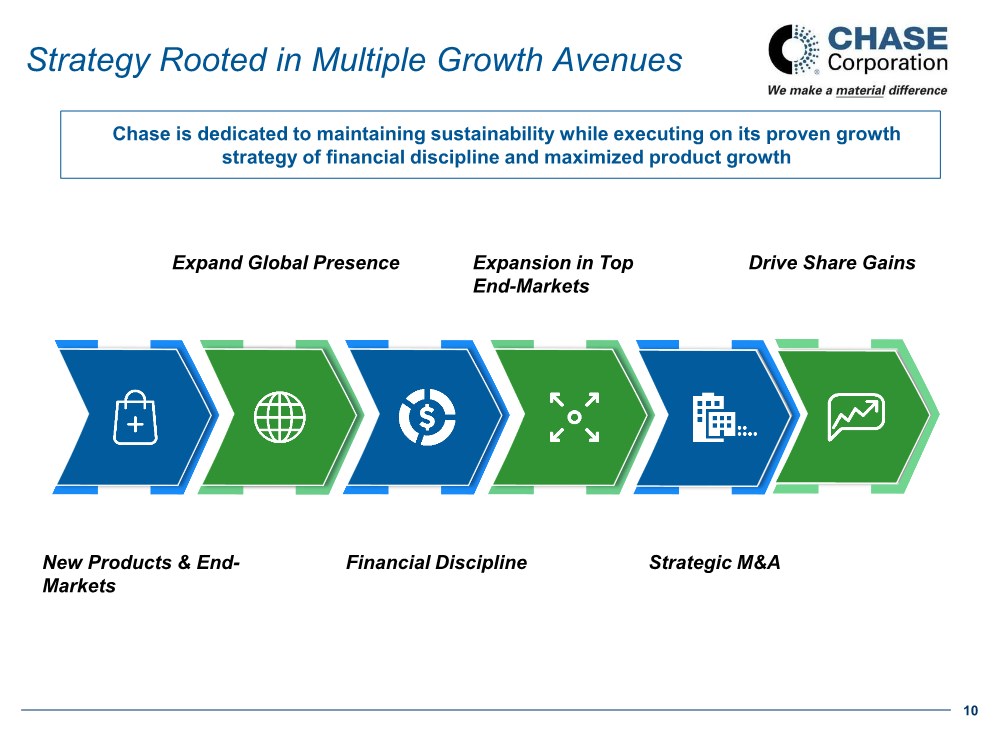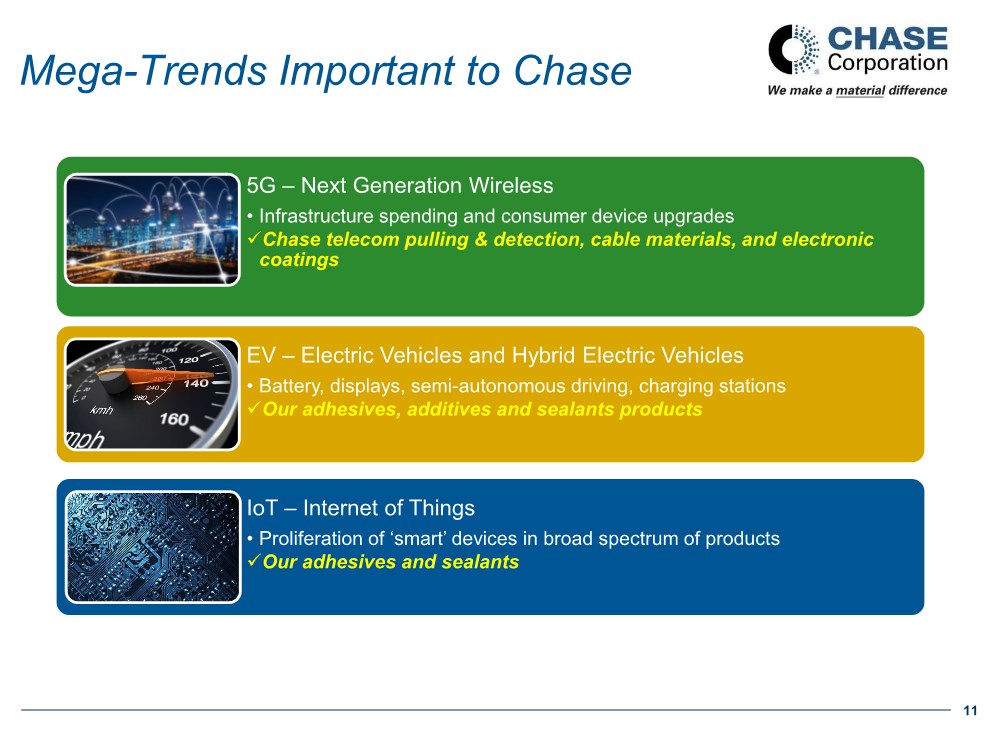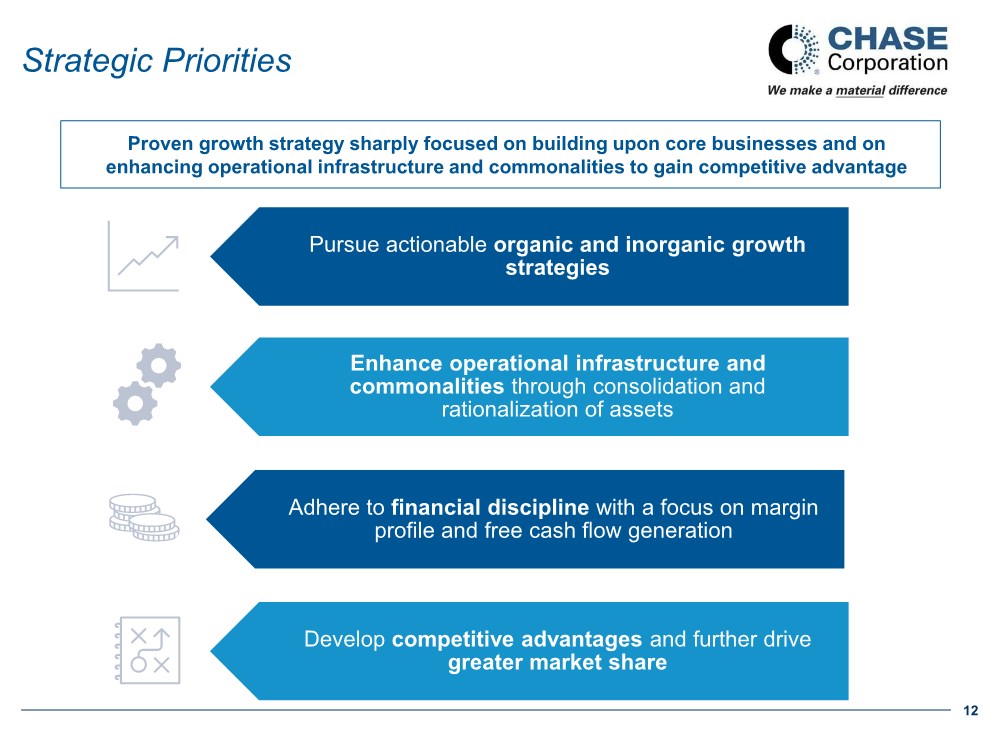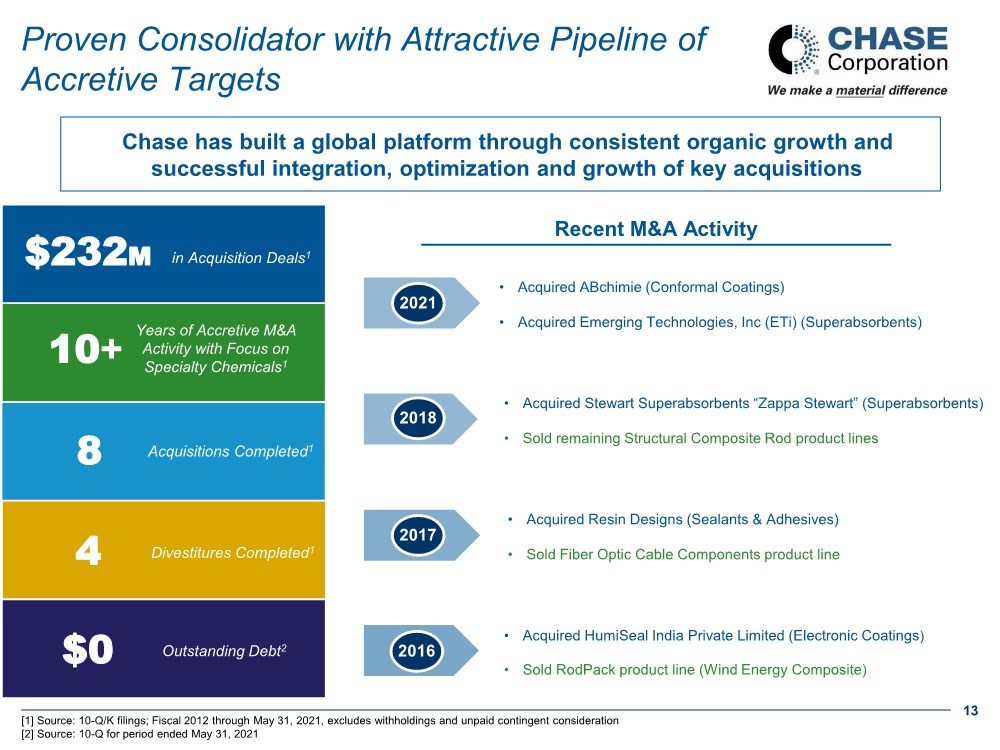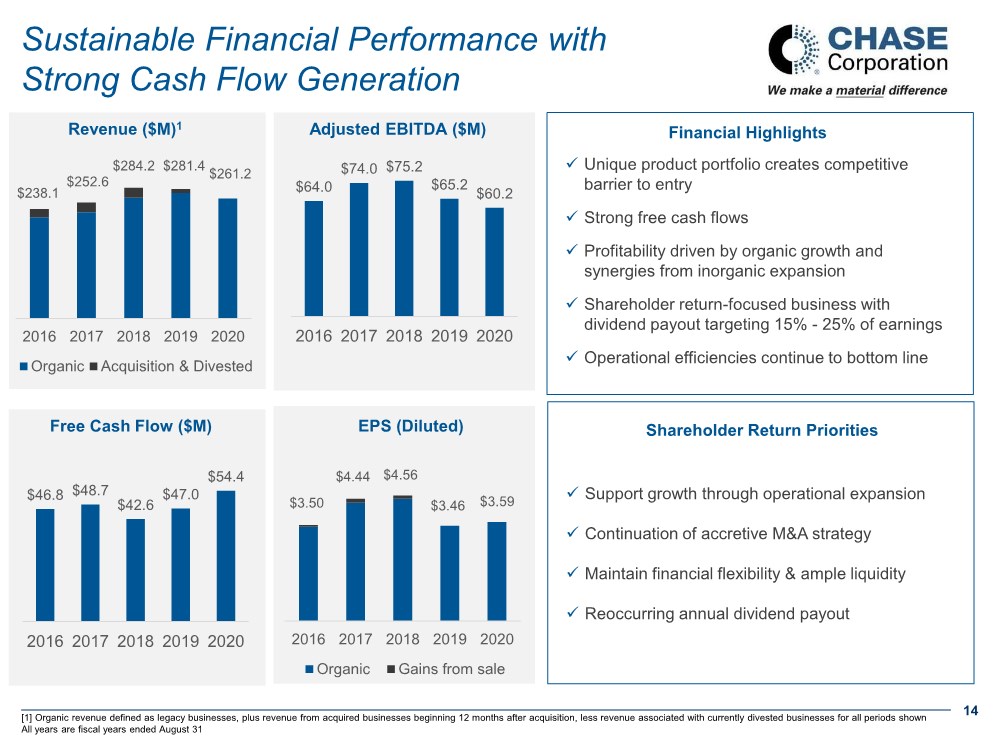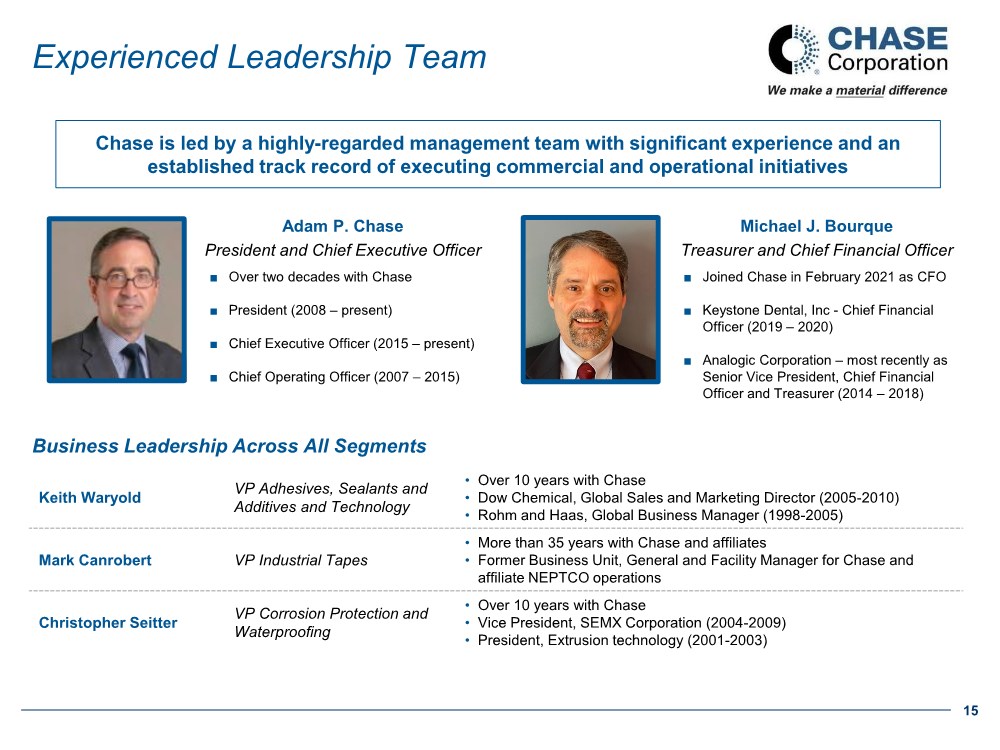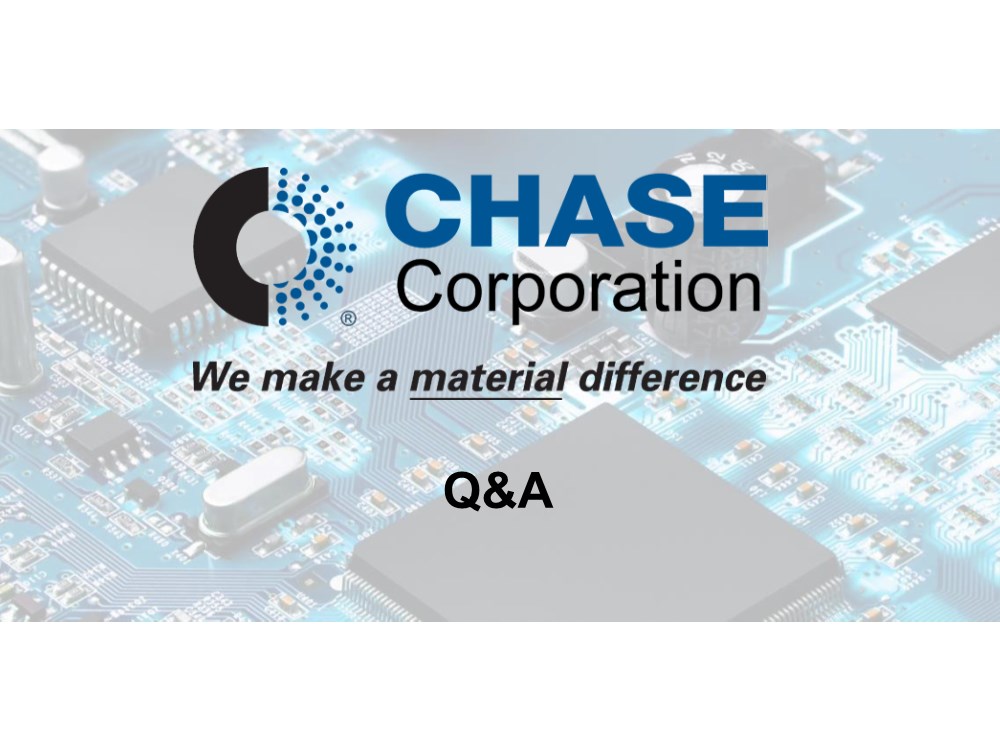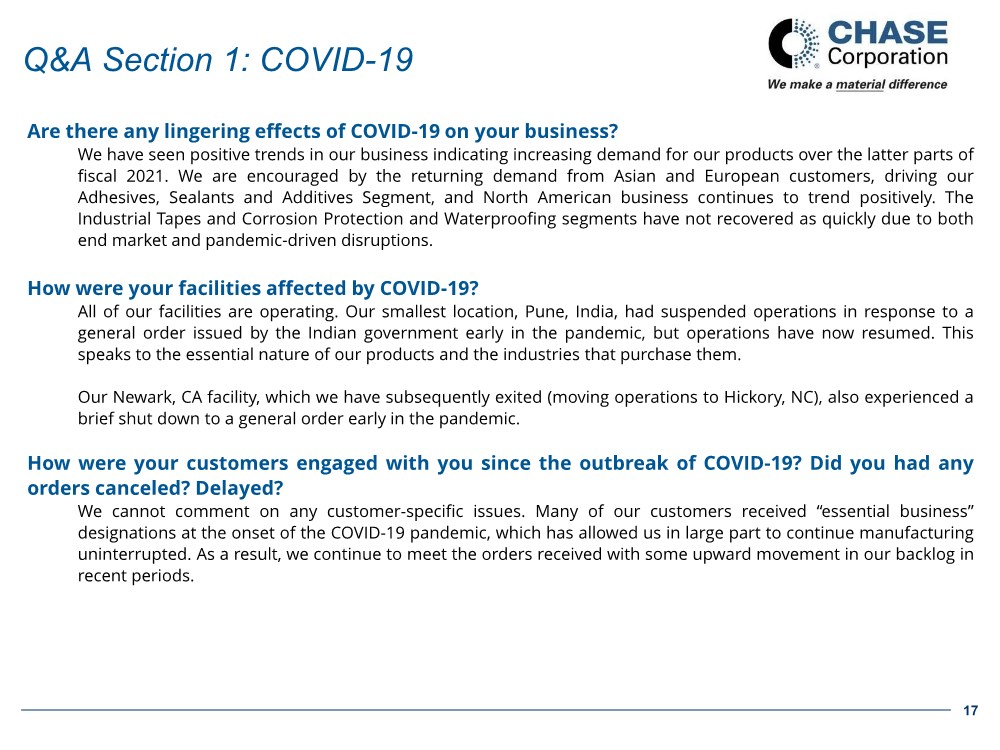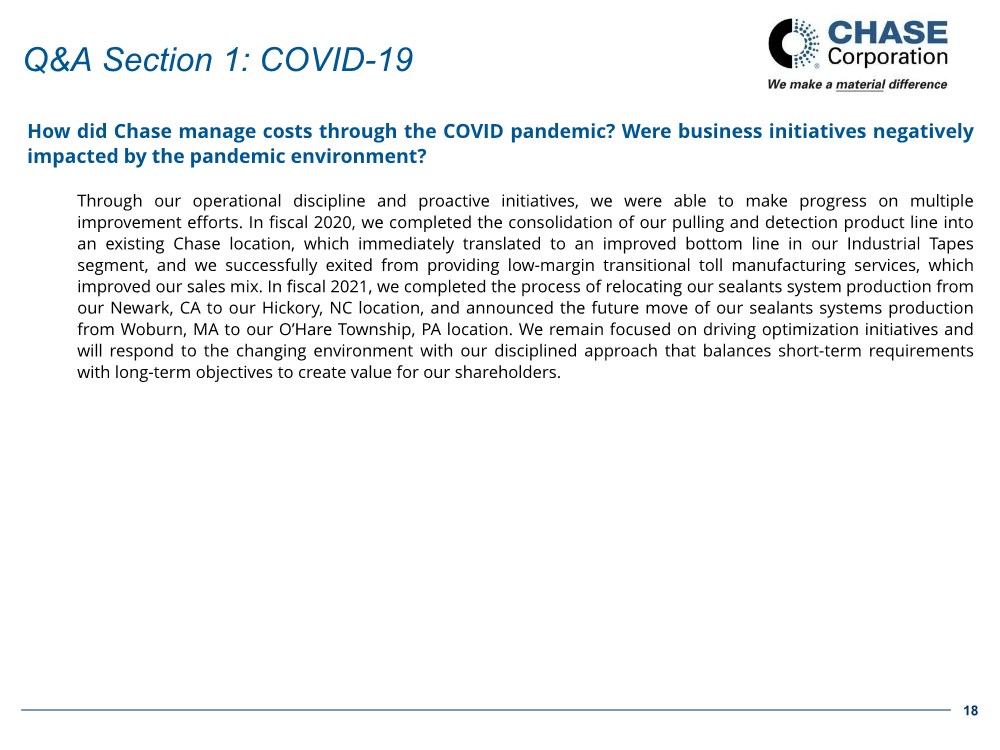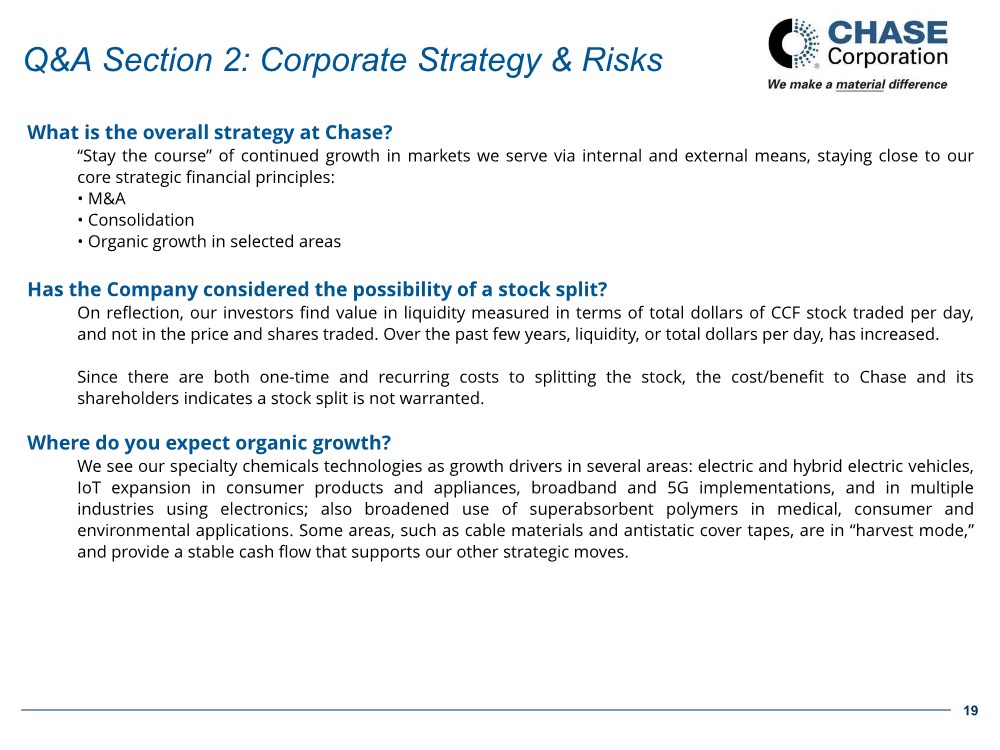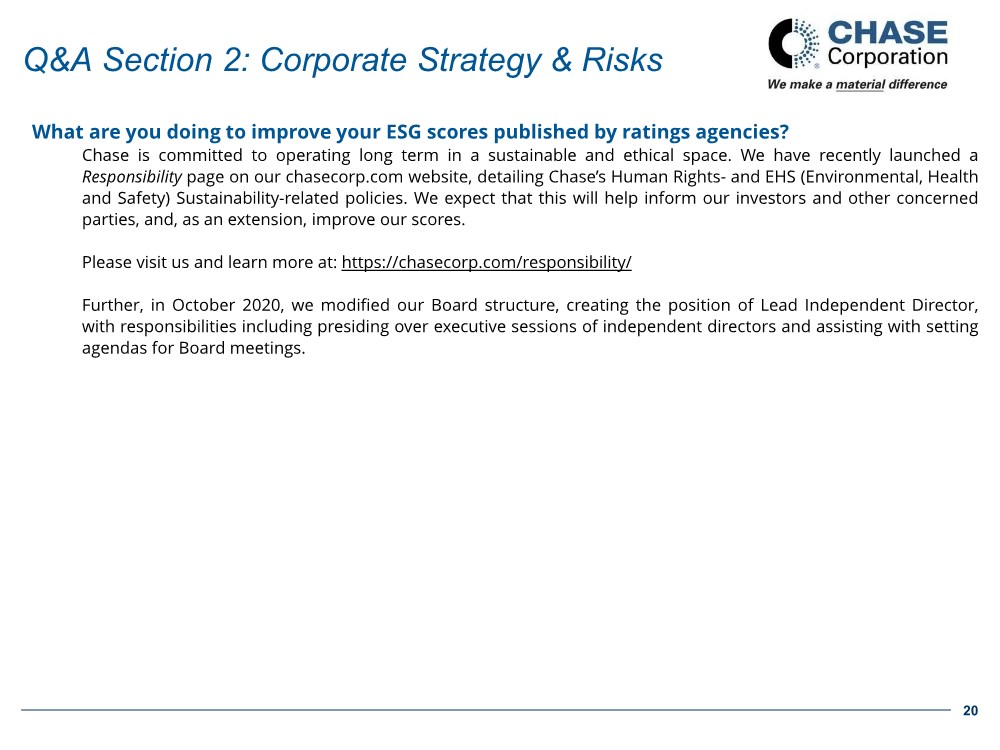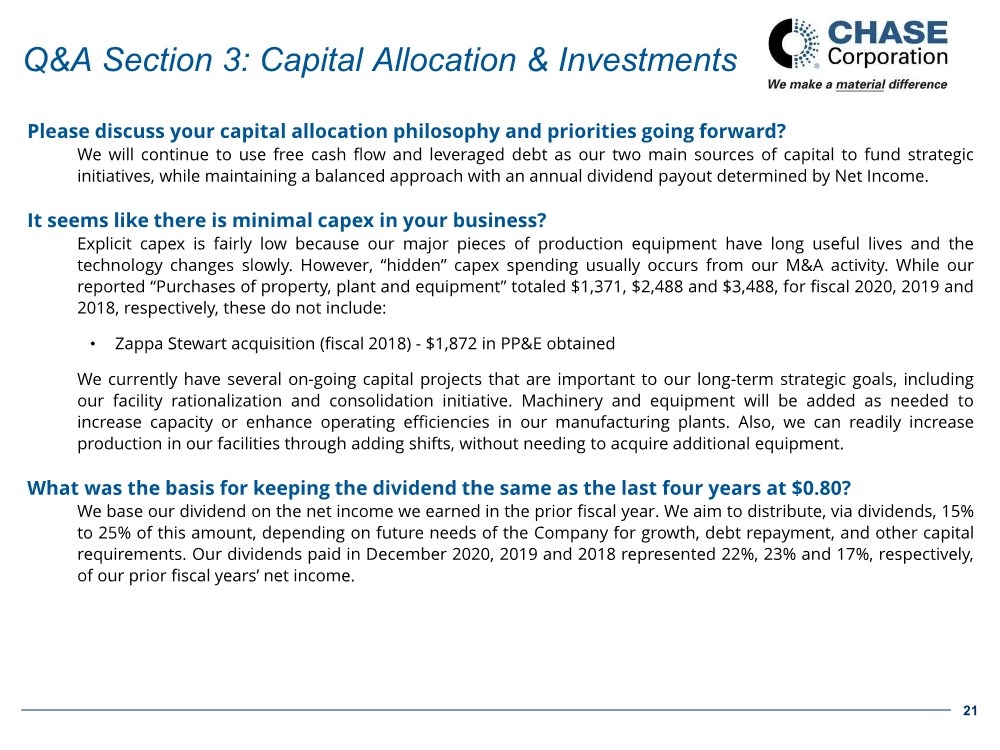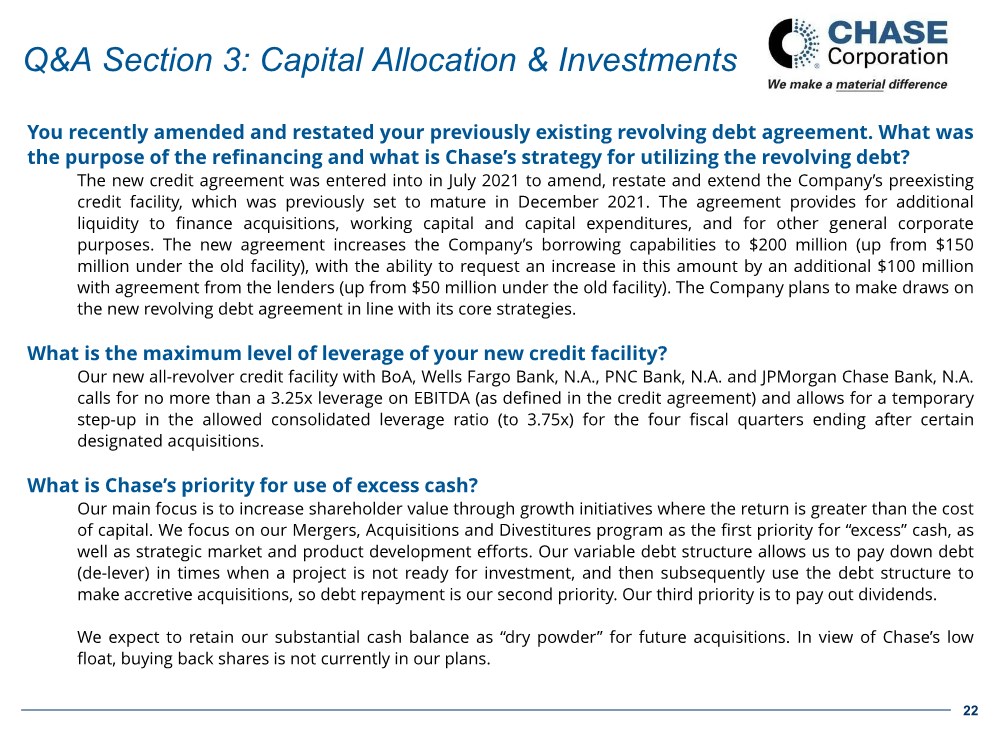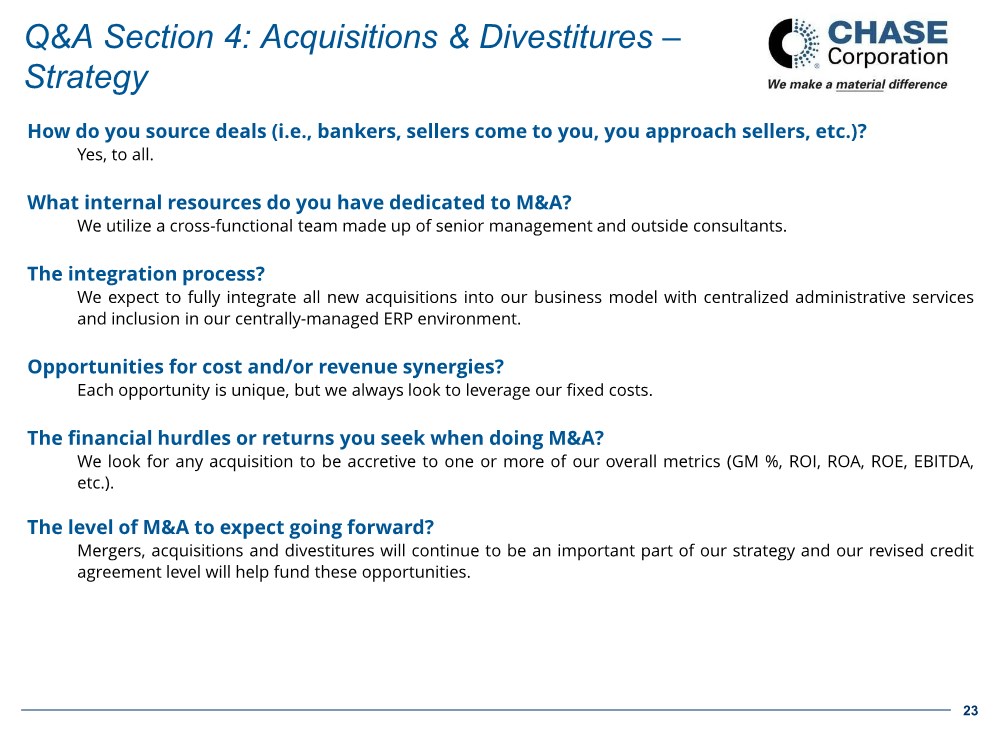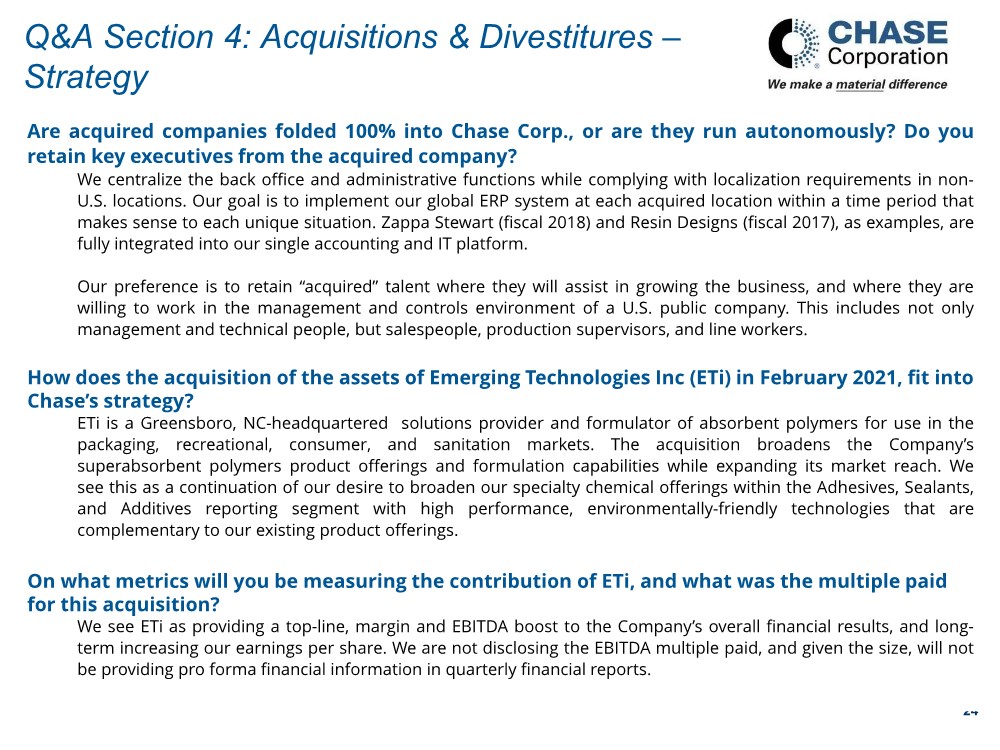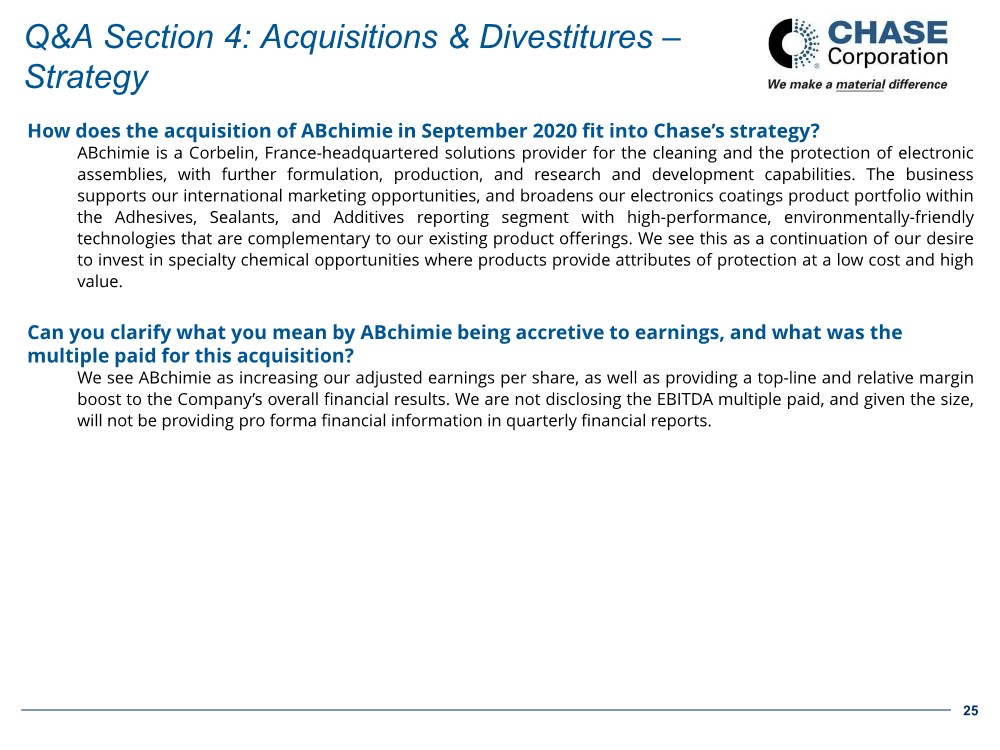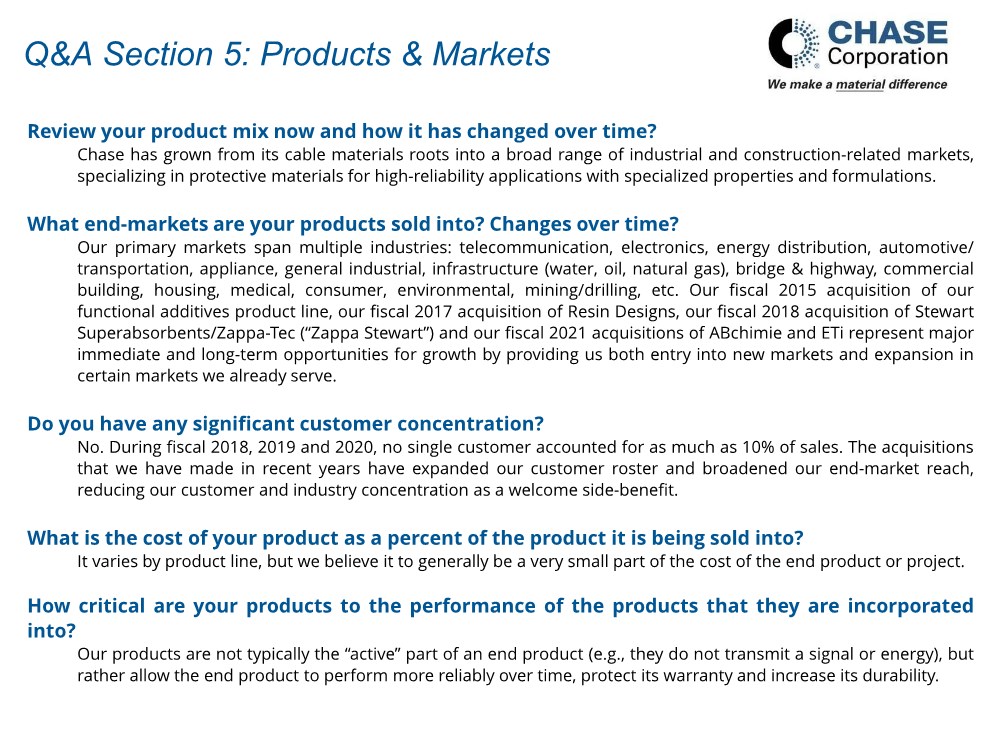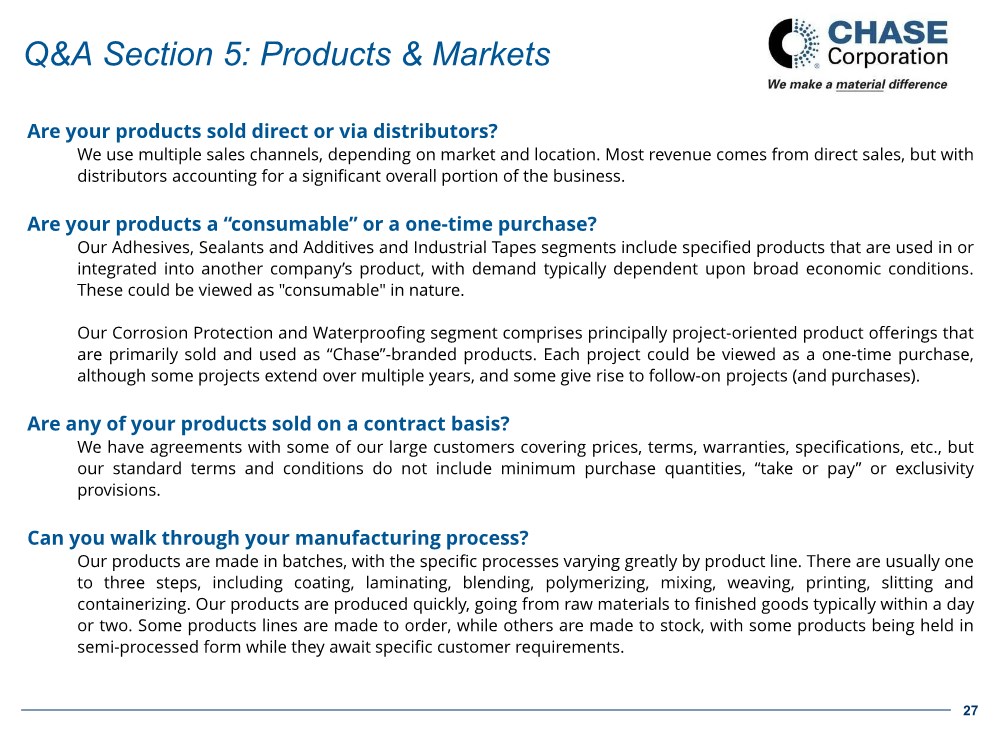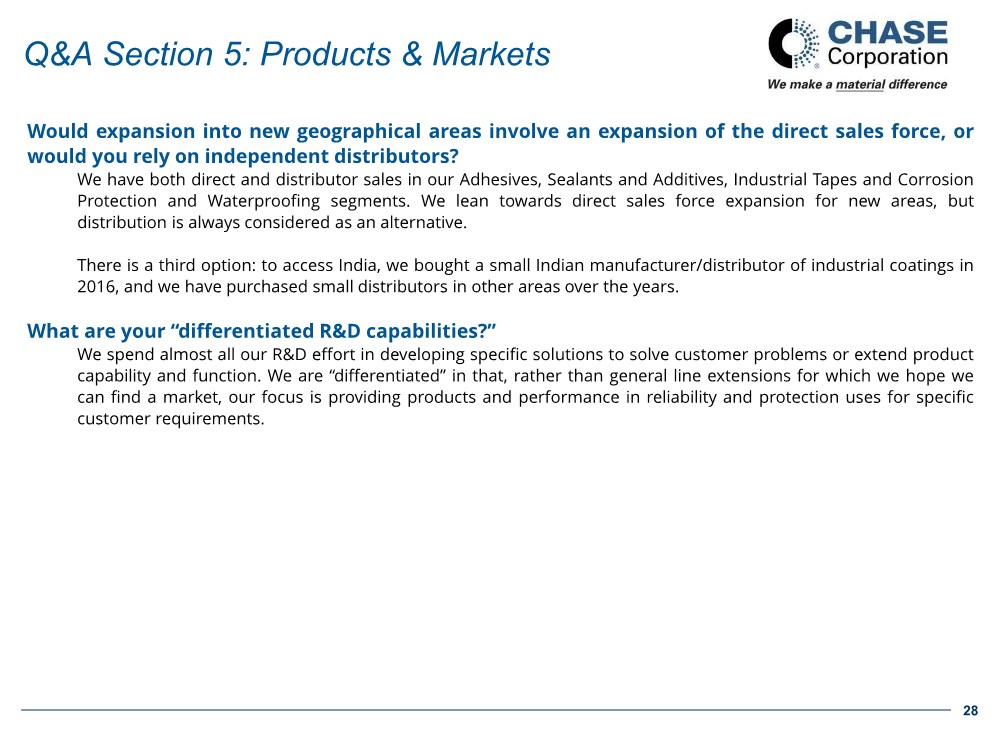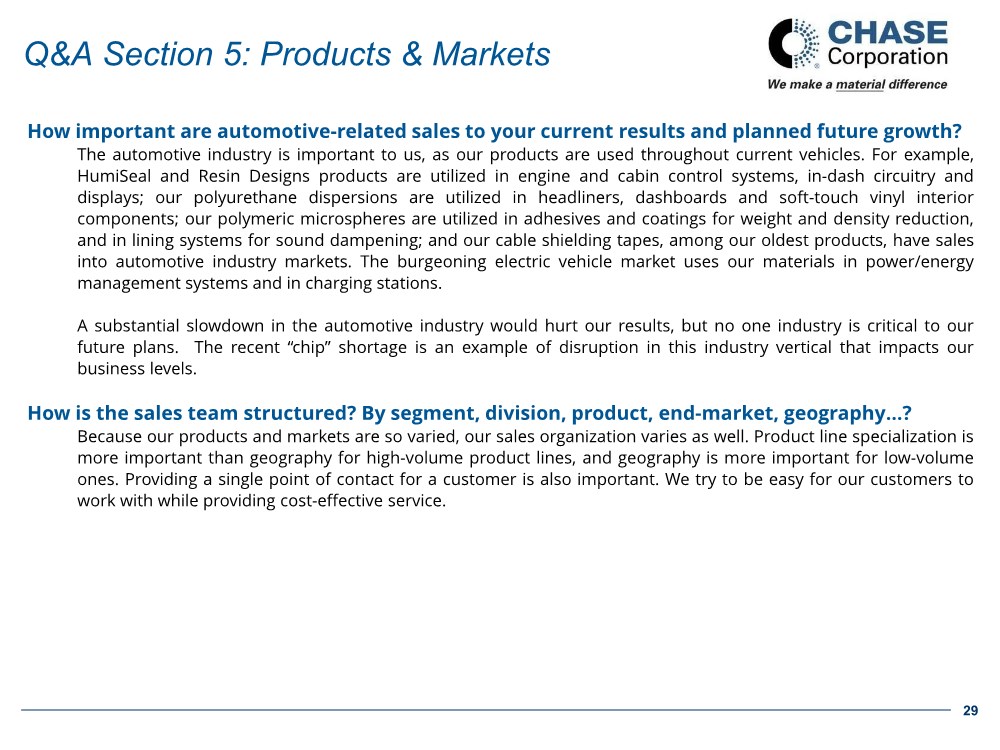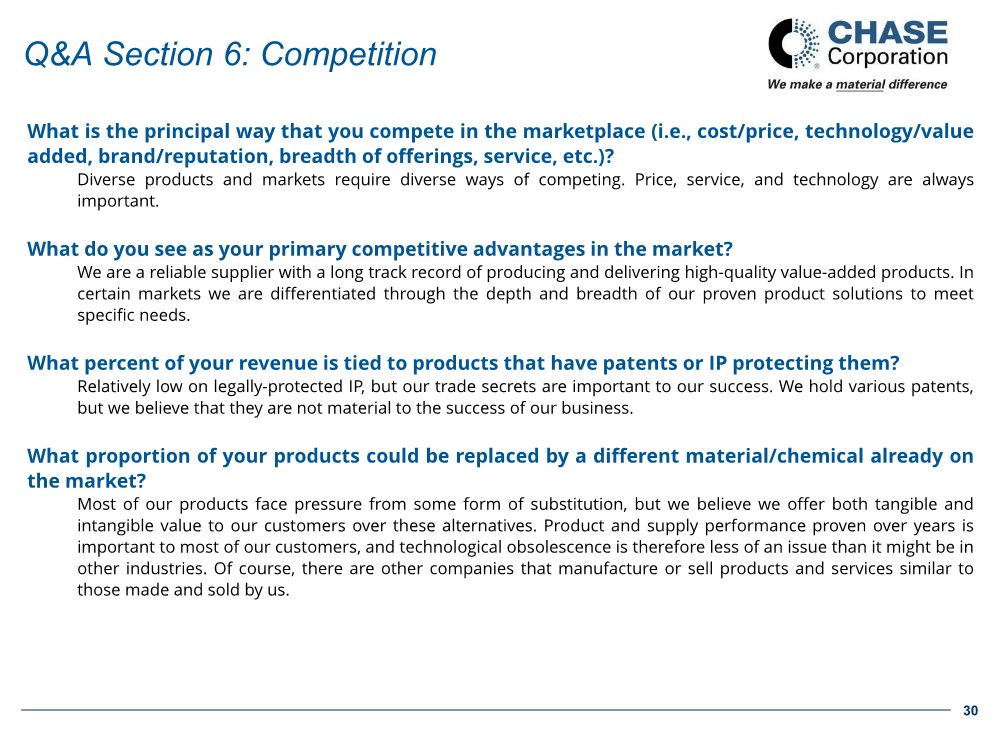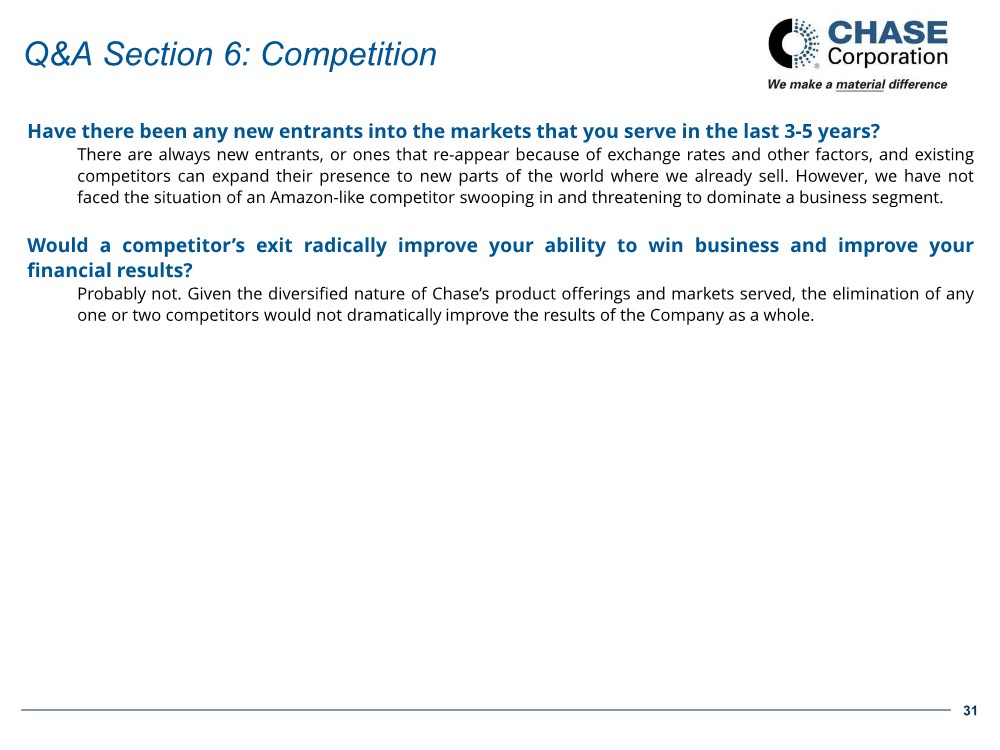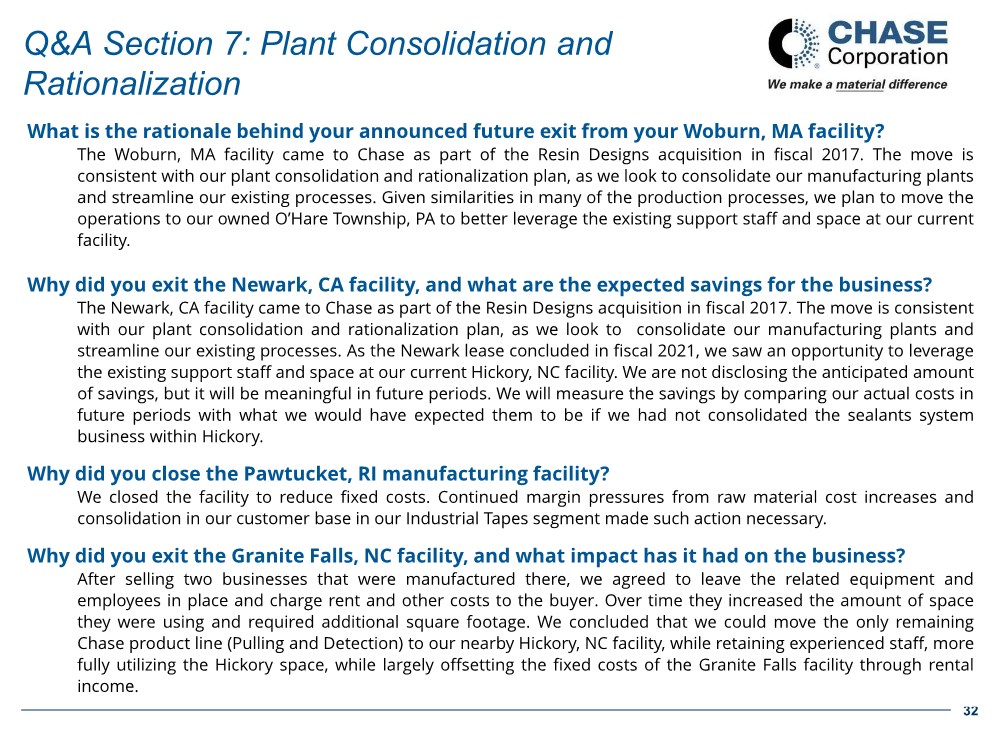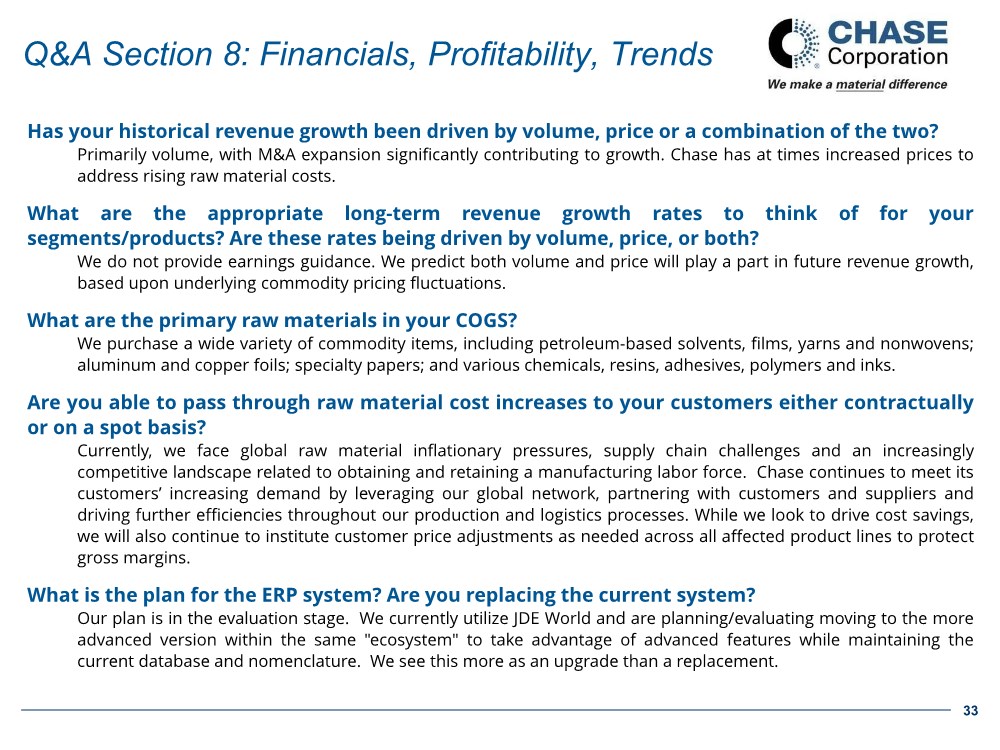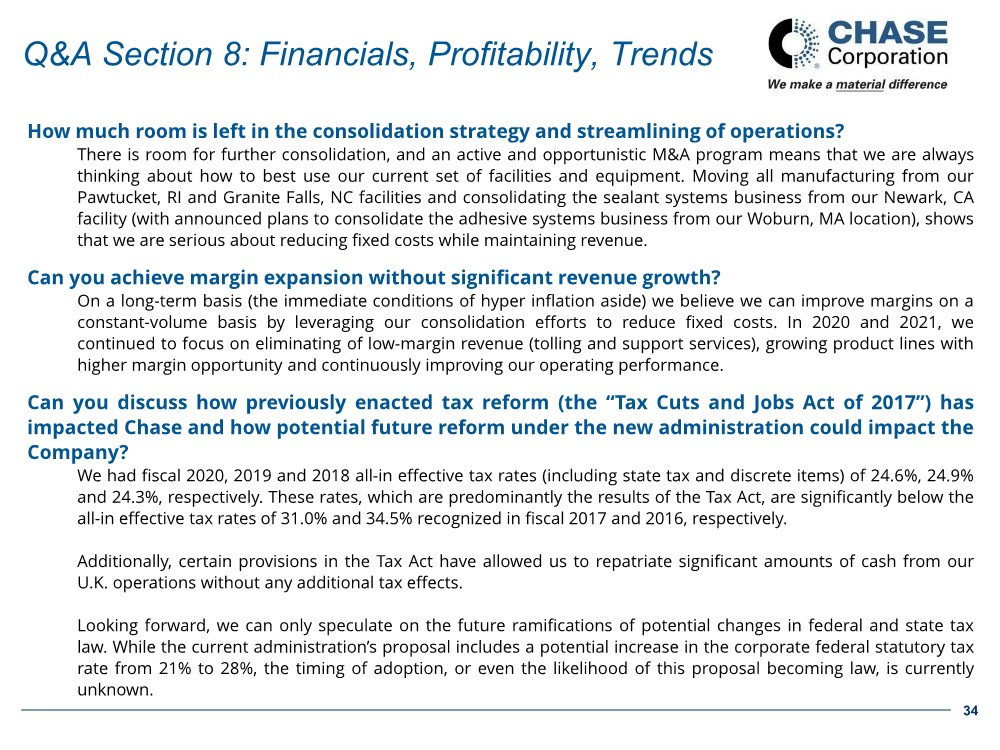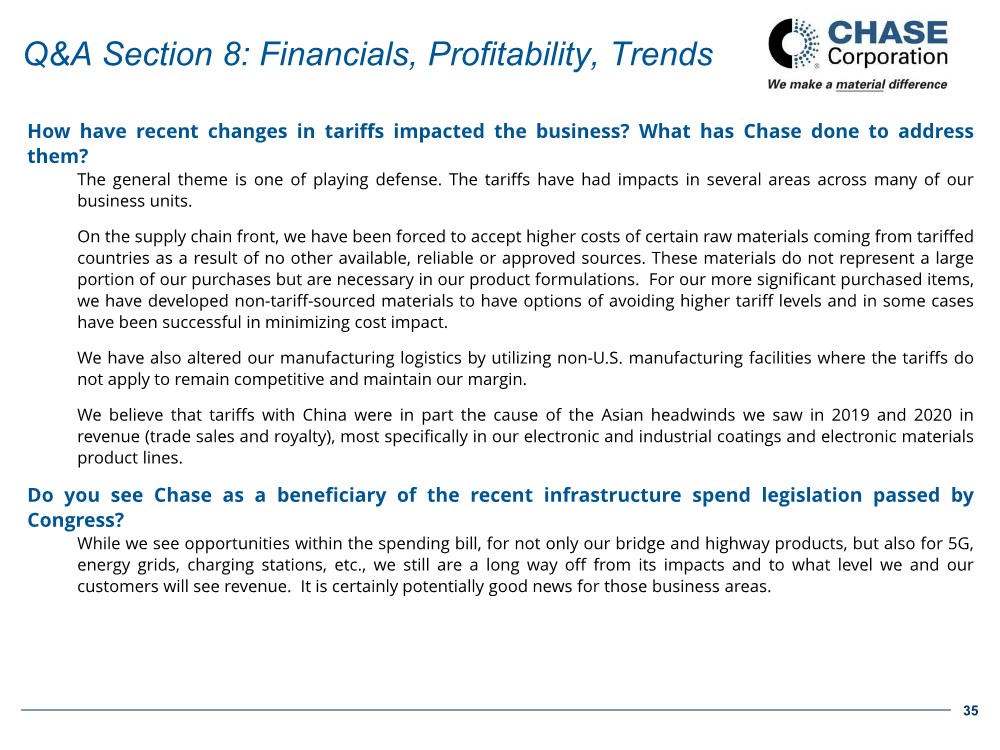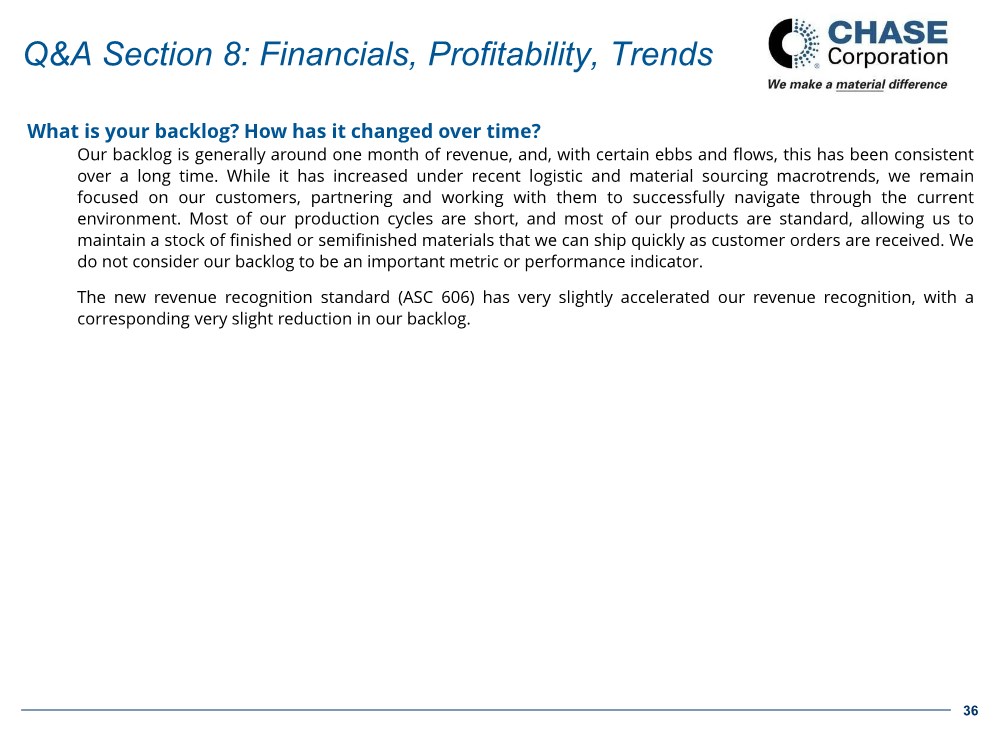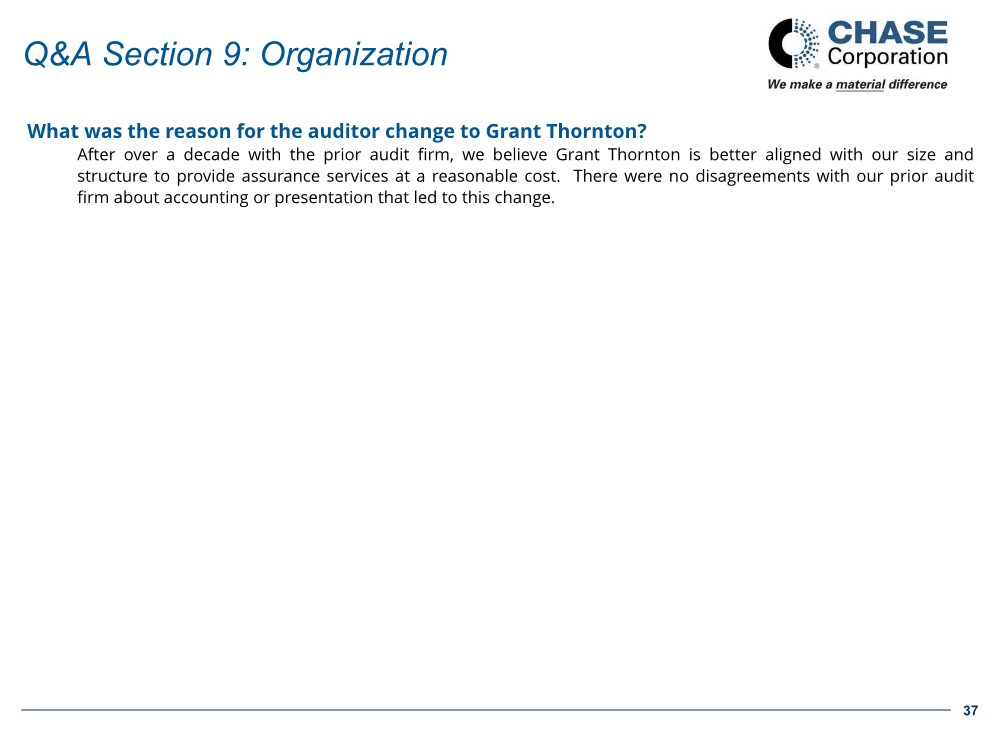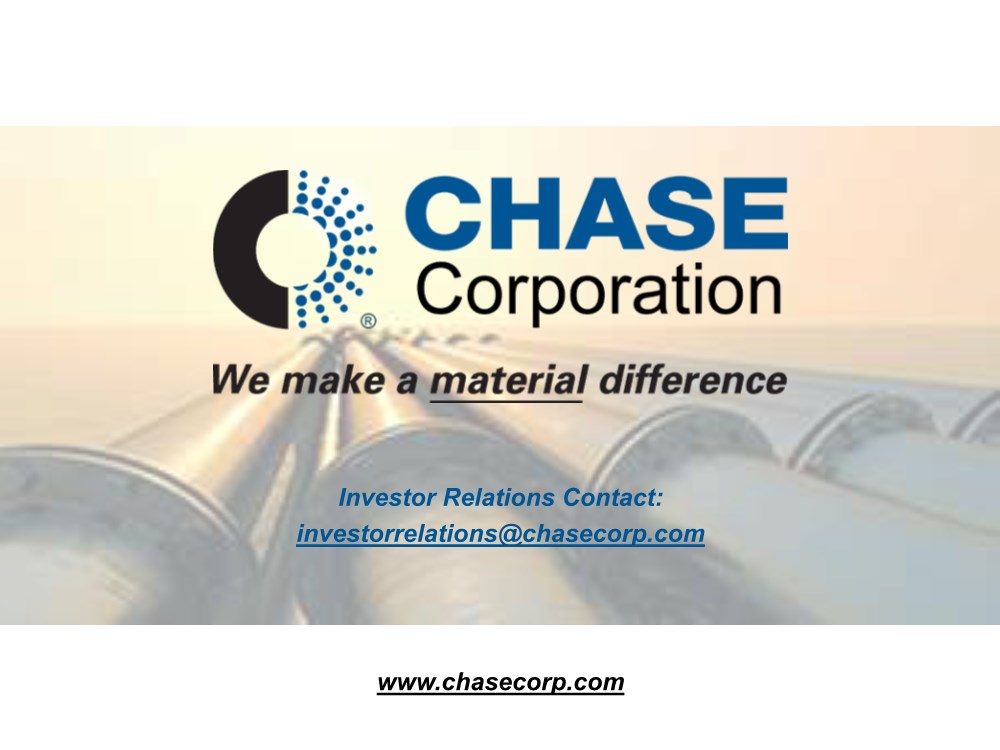Attached files
| file | filename |
|---|---|
| 8-K - 8-K - CHASE CORP | ccf-20210910x8k.htm |
Exhibit 99.1
| Investor Presentation September 2021 NYSE American: CCF |
| 2 Safe Harbor, Reference to Public Filings and Non-GAAP Measures Statements Forward-Looking Statements Certain statements in this presentation are forward-looking. These can be identified by the use of forward-looking words or phrases such as “believe”; “expect”; “anticipate”; “should”; “planned”; “estimated”; “forecasted”; “projected”; and “potential”, among others. These forward-looking statements are based on Chase Corporation’s current expectations. The Private Securities Litigation Reform Act of 1995 provides a “safe harbor” for such forward-looking statements. To comply with the terms of the safe harbor, the Company cautions investors that any forward-looking statements made by the Company are not guarantees of future performance and that a variety of factors could cause the Company's actual results and experience to differ materially from the anticipated results or other expectations expressed in the Company's forward-looking statements. The risks and uncertainties which may affect the operations, performance, development and results of the Company's business include, but are not limited to, the following: uncertainties relating to economic conditions; uncertainties relating to customer plans and commitments; the pricing and availability of equipment, materials and inventories; technological developments; performance issues with suppliers and subcontractors; economic growth; delays in testing of new products; the Company’s ability to successfully integrate acquired operations; the effectiveness of cost-reduction plans; expected impact of the coronavirus disease 2019 (COVID-19) pandemic on the Company's businesses; rapid technology changes and the highly competitive environment in which the Company operates. Important factors that could cause actual results to differ materially from our expectations are disclosed under Item 1A (“Risk Factors”) in our latest Annual Report on Form 10-K filed with the U.S. Securities and Exchange Commission, and subsequent Quarterly Reports on Form 10-Q and should be read together with this presentation. Readers are cautioned not to place undue reliance on these forward-looking statements, which speak only as of the date the statement was made. Further Information This presentation should be read together with “Management’s Discussion and Analysis of Financial Condition and Results of Operations” and the consolidated financial statements and the related notes thereto included in our public filings. Non-GAAP Financial Measures We believe that EBITDA, Adjusted EBITDA, Free Cash Flow and Organic Revenue are useful performance measures. They are used by our executive management team to measure operating performance, to allocate resources, to evaluate the effectiveness of our business strategies and to communicate with our Board of Directors concerning our financial performance. The Company believes EBITDA, Adjusted EBITDA, Free Cash Flow and Organic Revenue are also useful to investors. EBITDA is useful in comparing the core operations of the business from period to period by removing the impact of the Company’s capital structure (through interest expense), asset base (through depreciation and amortization) and tax rate, and in evaluating operating performance relative to others in the industry. Adjusted EBITDA allows for comparison to the Company’s performance in prior periods without the effect of items that, by their nature, tend to obscure the Company’s core operating results due to the potential variability across periods based on their timing, frequency and magnitude. Free Cash Flow provides a means for measuring the cash generated from operations that is available for mandatory obligations, including interest payments and debt repayment, and discretionary investment opportunities such as funding acquisitions, product and market development and paying dividends. As a result, management believes these metrics, which are commonly used by financial analysts and others in the industries in which the Company operates, enhance the ability of investors to analyze trends in the Company’s business and evaluate the Company’s performance relative to peer companies and the past performance of the Company itself. EBITDA, Adjusted EBITDA, Free Cash Flow and Organic Revenue are non-U.S. GAAP financial measures. We define EBITDA as net income before interest expense from borrowings, income tax expense, depreciation expense from fixed assets, and amortization expense from intangible assets. We define Adjusted EBITDA as EBITDA excluding costs and (gains) losses related to our acquisitions and divestitures, costs of products sold related to inventory step-up to fair value, settlement (gains) losses resulting from lump-sum distributions to participants from our defined benefit plans, operations optimization costs, impairment losses on long-lived assets, and other significant items. We define Free Cash Flow as net cash provided by operating activities less purchases of property, plant and equipment. Organic revenue is defined as legacy businesses, plus revenue from acquired businesses beginning 12 months after acquisition, less revenue associated with currently divested businesses for all periods shown. The use of EBITDA, Adjusted EBITDA, Free Cash Flow and Organic Revenue has limitations. These performance measures should not be considered in isolation from, or as an alternative to, U.S. GAAP measures such as net income, net cash provided by operating activities and revenue. Since we may have certain non-discretionary expenditures that are not deducted from these measures, including scheduled principal payments on outstanding debt, none of these measures should be interpreted as representing the residual cash flow of the Company available solely for discretionary expenditures or to invest in the growth of our business. Our measurement of EBITDA, Adjusted EBITDA, Free Cash Flow and Organic Revenue may not be comparable to similarly-titled measures used by other companies. |
| 3 Why Invest in Chase Corporation A global specialty chemicals company that is a leading manufacturer of protective materials for high-reliability applications across a broad range of market sectors Strategic diversification of product offerings for high-reliability applications. Chase’s solidified position as a trusted partner to customers brings long-term value for our shareholders. Effectively manages and rationalizes cost base to improve relative profitability results and operational performance. Proven growth strategy through organic and inorganic paths guides our capital allocation philosophy with a focus on return on investment. A continuous- improvement mindset focused on creating an ethical corporate culture. |
| 4 Chase Corporation at a Glance [1] Market capitalization data as of September 3, 2021 [2] Fiscal 2012 through May 31, 2021 [3] For fiscal year ended August 31, 2020, chart percentages rounded to sum to 100% NYSE:CCF Founded 1946, Headquarter in Westwood, MA 600+ Chase Employees $1.1B Market Capitalization1 8 Recent Acquisitions2 2020 Key Metrics3 ▪ Revenue: $261.2 Million ▪ Adjusted EBITDA: $60.2 Million ▪ Full Year Diluted EPS: $3.59 ▪ Gross Margin: 38% ▪ Free Cash Flow: $54.4 Million ▪ Annual Dividend: $0.80 World-Class Operational Platform Across 5 Countries Revenue by Geographic Region of Customers3 Revenue by Segment3 79% 12% 8% 1% North America Asia Europe All other Foreign 37% 45% 18% Adhesives, Sealants & Additives Industrial Tapes Corrosion Protection & Waterproofing |
| 5 Adhesives, sealants and additives leverage core specialty chemical development competencies of the Company. Numerous construction-related products solve a range of challenging problems for the oil, gas, water, wastewater, bridge, highway and associated industries. Corrosion Protection & Waterproofing Adhesives, Sealants & Additives Industrial Tapes Expansive brand offerings include wire and cable materials, specialty tapes, and other laminated and coated products. Three Strategic Operating Segments |
| 6 Adhesives, Sealants and Additives Product Offerings Select Markets [1] ABchimie acquired September 1, 2020 (FY21); Emerging Technologies, Inc (ETi) acquired February 5, 2021 [2] Source: FY20 Annual Report • Electronic & Industrial Coatings • Conformal coatings • Adhesives and sealants • Functional Additives • Polymeric microspheres • Superabsorbent polymers • Polyurethane dispersions 1 1 Electronic and Industrial Coatings, and Functional Additives Protective coatings, adhesives and additives to ensure reliability of our customers’ product functionality ✓ Revenue: $96.2M ✓ Gross Margin (%): 42% 2020 Financial Performance2 Aerospace Automotive Electronics Appliances Medical Environmental Coatings Intermediaries |
| 7 Industrial Tapes Product Offerings • Cable Materials • Shielding, binding, bedding and barrier tapes • Strand seal compounds • Specialty Tapes, Coatings and Laminates • Detection tapes • Pulling tapes • Antistatic cover tapes • Specialty manufacturing [1] Source: FY20 Annual Report Customizable solutions are engineered with broad analytical and developmental capabilities supported by an experienced technical staff Laminated and coated films, fillers and high-strength woven materials, which protect end-products from damage and environmental influences ✓ Revenue: $119.0M ✓ Gross Margin (%): 32% 2020 Financial Performance1 Select Markets Energy Industrial Electronics Oil & Gas Consumer & Packaging Utilities & Telecom |
| 8 Corrosion Protection and Waterproofing Product Offerings • Pipeline Coatings • Casing fill services • Hot- and Cold-applied tapes • Epoxy systems • Liquid coatings and primers • Protective Coatings, Linings & Additives • Asphalt waterproofing additives • Expansion and control joint systems • Waterproofing membranes • Coating and lining systems [1] Source: FY20 Annual Report Chase has harnessed qualities of a spectrum of chemistries to develop complete and respected product lines across numerous industries Durable adhesive tapes and high-strength flexible coating materials and additives which protect infrastructure from exposure to environmental influences ✓ Revenue: $46.0M ✓ Gross Margin (%): 45% 2020 Financial Performance1 Select Markets Water Wastewater Oil & Gas Infrastructure |
| 9 Chase is a Brand Leader Across All Segments ADHESIVES, SEALENTS & ADDITIVES PRODUCT 02 PRODUCT 03 Product Offerings Key Products Select Markets Brand Names Electronic & Industrial Coatings Functional Additives • Conformal coatings • Adhesives & sealants • Polymeric microspheres • Polyurethane dispersions • Superabsorbent polymers Corrosion Protection & Waterproofing Adhesives, Sealants & Additives Industrial Tapes • Aerospace • Automotive • Electronics • Appliances • Medical • Environmental • Intermediates • Coatings Cable Materials Specialty Tapes, Coatings and Laminates • Power cable tapes • Communication cable tapes • Strand seal compounds • Detection tapes • Pulling tapes • Durable paper products • Antistatic cover tapes • Specialty manufacturing • Energy • Electronics • Industrial • Oil & Gas • Consumer & Packaging • Utilities & Telecom Pipeline Coatings Protective Coatings, Linings & Additives • Casing fill services • Cold-applied tapes • Hot-applied tapes • Epoxy systems • Liquid coatings and primers • Asphalt waterproofing additives • Expansion & control joint systems • Waterproofing membranes • Coating & lining systems • Water • Wastewater • Oil & Gas • Infrastructure • Water |
| 10 Expand Global Presence Drive Share Gains Expansion in Top End-Markets Financial Discipline Strategic M&A New Products & End- Markets Chase is dedicated to maintaining sustainability while executing on its proven growth strategy of financial discipline and maximized product growth 05 Strategy Rooted in Multiple Growth Avenues |
| 11 Mega-Trends Important to Chase 5G – Next Generation Wireless • Infrastructure spending and consumer device upgrades ✓Chase telecom pulling & detection, cable materials, and electronic coatings EV – Electric Vehicles and Hybrid Electric Vehicles • Battery, displays, semi-autonomous driving, charging stations ✓Our adhesives, additives and sealants products IoT – Internet of Things • Proliferation of ‘smart’ devices in broad spectrum of products ✓Our adhesives and sealants |
| 12 Strategic Priorities Proven growth strategy sharply focused on building upon core businesses and on enhancing operational infrastructure and commonalities to gain competitive advantage Pursue actionable organic and inorganic growth strategies Enhance operational infrastructure and commonalities through consolidation and rationalization of assets Adhere to financial discipline with a focus on margin profile and free cash flow generation Develop competitive advantages and further drive greater market share |
| 13 Proven Consolidator with Attractive Pipeline of Accretive Targets Chase has built a global platform through consistent organic growth and successful integration, optimization and growth of key acquisitions • Acquired Resin Designs (Sealants & Adhesives) • Sold Fiber Optic Cable Components product line 2017 • Acquired HumiSeal India Private Limited (Electronic Coatings) • Sold RodPack product line (Wind Energy Composite) 2016 • Acquired Stewart Superabsorbents “Zappa Stewart” (Superabsorbents) • Sold remaining Structural Composite Rod product lines 2018 2021 • Acquired ABchimie (Conformal Coatings) • Acquired Emerging Technologies, Inc (ETi) (Superabsorbents) in Acquisition Deals1 $232M Acquisitions Completed1 8 Divestitures Completed1 4 Years of Accretive M&A Activity with Focus on Specialty Chemicals1 10+ Outstanding Debt2 $0 [1] Source: 10-Q/K filings; Fiscal 2012 through May 31, 2021, excludes withholdings and unpaid contingent consideration [2] Source: 10-Q for period ended May 31, 2021 Recent M&A Activity |
| 14 [1] Organic revenue defined as legacy businesses, plus revenue from acquired businesses beginning 12 months after acquisition, less revenue associated with currently divested businesses for all periods shown All years are fiscal years ended August 31 Sustainable Financial Performance with Strong Cash Flow Generation Revenue ($M)1 Financial Highlights Adjusted EBITDA ($M) Free Cash Flow ($M) EPS (Diluted) Shareholder Return Priorities ✓ Unique product portfolio creates competitive barrier to entry ✓ Strong free cash flows ✓ Profitability driven by organic growth and synergies from inorganic expansion ✓ Shareholder return-focused business with dividend payout targeting 15% - 25% of earnings ✓ Operational efficiencies continue to bottom line ✓ Support growth through operational expansion ✓ Continuation of accretive M&A strategy ✓ Maintain financial flexibility & ample liquidity ✓ Reoccurring annual dividend payout 2016 2017 2018 2019 2020 Organic Acquisition & Divested $238.1 $252.6 $284.2 $281.4 $261.2 $64.0 $74.0 $75.2 $65.2 $60.2 2016 2017 2018 2019 2020 $46.8 $48.7 $42.6 $47.0 $54.4 2016 2017 2018 2019 2020 2016 2017 2018 2019 2020 Organic Gains from sale $3.50 $4.44 $4.56 $3.46 $3.59 |
| 15 Michael J. Bourque Treasurer and Chief Financial Officer ■ Joined Chase in February 2021 as CFO ■ Keystone Dental, Inc - Chief Financial Officer (2019 – 2020) ■ Analogic Corporation – most recently as Senior Vice President, Chief Financial Officer and Treasurer (2014 – 2018) Adam P. Chase President and Chief Executive Officer ■ Over two decades with Chase ■ President (2008 – present) ■ Chief Executive Officer (2015 – present) ■ Chief Operating Officer (2007 – 2015) Experienced Leadership Team Chase is led by a highly-regarded management team with significant experience and an established track record of executing commercial and operational initiatives Keith Waryold VP Adhesives, Sealants and Additives and Technology • Over 10 years with Chase • Dow Chemical, Global Sales and Marketing Director (2005-2010) • Rohm and Haas, Global Business Manager (1998-2005) Mark Canrobert VP Industrial Tapes • More than 35 years with Chase and affiliates • Former Business Unit, General and Facility Manager for Chase and affiliate NEPTCO operations Christopher Seitter VP Corrosion Protection and Waterproofing • Over 10 years with Chase • Vice President, SEMX Corporation (2004-2009) • President, Extrusion technology (2001-2003) Business Leadership Across All Segments |
| Q&A |
| 17 Q&A Section 1: COVID-19 Are there any lingering effects of COVID-19 on your business? We have seen positive trends in our business indicating increasing demand for our products over the latter parts of fiscal 2021. We are encouraged by the returning demand from Asian and European customers, driving our Adhesives, Sealants and Additives Segment, and North American business continues to trend positively. The Industrial Tapes and Corrosion Protection and Waterproofing segments have not recovered as quickly due to both end market and pandemic-driven disruptions. How were your facilities affected by COVID-19? All of our facilities are operating. Our smallest location, Pune, India, had suspended operations in response to a general order issued by the Indian government early in the pandemic, but operations have now resumed. This speaks to the essential nature of our products and the industries that purchase them. Our Newark, CA facility, which we have subsequently exited (moving operations to Hickory, NC), also experienced a brief shut down to a general order early in the pandemic. How were your customers engaged with you since the outbreak of COVID-19? Did you had any orders canceled? Delayed? We cannot comment on any customer-specific issues. Many of our customers received “essential business” designations at the onset of the COVID-19 pandemic, which has allowed us in large part to continue manufacturing uninterrupted. As a result, we continue to meet the orders received with some upward movement in our backlog in recent periods. |
| 18 Q&A Section 1: COVID-19 How did Chase manage costs through the COVID pandemic? Were business initiatives negatively impacted by the pandemic environment? Through our operational discipline and proactive initiatives, we were able to make progress on multiple improvement efforts. In fiscal 2020, we completed the consolidation of our pulling and detection product line into an existing Chase location, which immediately translated to an improved bottom line in our Industrial Tapes segment, and we successfully exited from providing low-margin transitional toll manufacturing services, which improved our sales mix. In fiscal 2021, we completed the process of relocating our sealants system production from our Newark, CA to our Hickory, NC location, and announced the future move of our sealants systems production from Woburn, MA to our O’Hare Township, PA location. We remain focused on driving optimization initiatives and will respond to the changing environment with our disciplined approach that balances short-term requirements with long-term objectives to create value for our shareholders. |
| 19 Q&A Section 2: Corporate Strategy & Risks What is the overall strategy at Chase? “Stay the course” of continued growth in markets we serve via internal and external means, staying close to our core strategic financial principles: • M&A • Consolidation • Organic growth in selected areas Has the Company considered the possibility of a stock split? On reflection, our investors find value in liquidity measured in terms of total dollars of CCF stock traded per day, and not in the price and shares traded. Over the past few years, liquidity, or total dollars per day, has increased. Since there are both one-time and recurring costs to splitting the stock, the cost/benefit to Chase and its shareholders indicates a stock split is not warranted. Where do you expect organic growth? We see our specialty chemicals technologies as growth drivers in several areas: electric and hybrid electric vehicles, IoT expansion in consumer products and appliances, broadband and 5G implementations, and in multiple industries using electronics; also broadened use of superabsorbent polymers in medical, consumer and environmental applications. Some areas, such as cable materials and antistatic cover tapes, are in “harvest mode,” and provide a stable cash flow that supports our other strategic moves. |
| 20 Q&A Section 2: Corporate Strategy & Risks What are you doing to improve your ESG scores published by ratings agencies? Chase is committed to operating long term in a sustainable and ethical space. We have recently launched a Responsibility page on our chasecorp.com website, detailing Chase’s Human Rights- and EHS (Environmental, Health and Safety) Sustainability-related policies. We expect that this will help inform our investors and other concerned parties, and, as an extension, improve our scores. Please visit us and learn more at: https://chasecorp.com/responsibility/ Further, in October 2020, we modified our Board structure, creating the position of Lead Independent Director, with responsibilities including presiding over executive sessions of independent directors and assisting with setting agendas for Board meetings. |
| 21 Q&A Section 3: Capital Allocation & Investments Please discuss your capital allocation philosophy and priorities going forward? We will continue to use free cash flow and leveraged debt as our two main sources of capital to fund strategic initiatives, while maintaining a balanced approach with an annual dividend payout determined by Net Income. It seems like there is minimal capex in your business? Explicit capex is fairly low because our major pieces of production equipment have long useful lives and the technology changes slowly. However, “hidden” capex spending usually occurs from our M&A activity. While our reported “Purchases of property, plant and equipment” totaled $1,371, $2,488 and $3,488, for fiscal 2020, 2019 and 2018, respectively, these do not include: • Zappa Stewart acquisition (fiscal 2018)- $1,872 in PP&E obtained We currently have several on-going capital projects that are important to our long-term strategic goals, including our facility rationalization and consolidation initiative. Machinery and equipment will be added as needed to increase capacity or enhance operating efficiencies in our manufacturing plants. Also, we can readily increase production in our facilities through adding shifts, without needing to acquire additional equipment. What was the basis for keeping the dividend the same as the last four years at $0.80? We base our dividend on the net income we earned in the prior fiscal year. We aim to distribute, via dividends, 15% to 25% of this amount, depending on future needs of the Company for growth, debt repayment, and other capital requirements. Our dividends paid in December 2020, 2019 and 2018 represented 22%, 23% and 17%, respectively, of our prior fiscal years’ net income. |
| 22 Q&A Section 3: Capital Allocation & Investments You recently amended and restated your previously existing revolving debt agreement.What was the purpose of the refinancing and what is Chase’s strategy for utilizing the revolving debt? The new credit agreement was entered into in July 2021 to amend, restate and extend the Company’s preexisting credit facility, which was previously set to mature in December 2021.The agreement provides for additional liquidity to finance acquisitions, working capital and capital expenditures, and for other general corporate purposes. The new agreement increases the Company’s borrowing capabilities to $200 million (up from $150 million under the old facility), with the ability to request an increase in this amount by an additional $100 million with agreement from the lenders (up from $50 million under the old facility). The Company plans to make draws on the new revolving debt agreement in line with its core strategies. What is the maximum level of leverage of your new credit facility? Our new all-revolver credit facility with BoA, Wells Fargo Bank, N.A., PNC Bank, N.A. and JPMorgan Chase Bank, N.A. calls for no more than a 3.25x leverage on EBITDA (as defined in the credit agreement) and allows for a temporary step-up in the allowed consolidated leverage ratio (to 3.75x) for the four fiscal quarters ending after certain designated acquisitions. What is Chase’s priority for use of excess cash? Our main focus is to increase shareholder value through growth initiatives where the return is greater than the cost of capital. We focus on our Mergers, Acquisitions and Divestitures program as the first priority for “excess” cash, as well as strategic market and product development efforts. Our variable debt structure allows us to pay down debt (de-lever) in times when a project is not ready for investment, and then subsequently use the debt structure to make accretive acquisitions, so debt repayment is our second priority. Our third priority is to pay out dividends. We expect to retain our substantial cash balance as “dry powder” for future acquisitions. In view of Chase’s low float, buying back shares is not currently in our plans. |
| 23 Q&A Section 4: Acquisitions & Divestitures – Strategy How do you source deals (i.e., bankers, sellers come to you, you approach sellers, etc.)? Yes, to all. What internal resources do you have dedicated to M&A? We utilize a cross-functional team made up of senior management and outside consultants. The integration process? We expect to fully integrate all new acquisitions into our business model with centralized administrative services and inclusion in our centrally-managed ERP environment. Opportunities for cost and/or revenue synergies? Each opportunity is unique, but we always look to leverage our fixed costs. The financial hurdles or returns you seek when doing M&A? We look for any acquisition to be accretive to one or more of our overall metrics (GM %, ROI, ROA, ROE, EBITDA, etc.). The level of M&A to expect going forward? Mergers, acquisitions and divestitures will continue to be an important part of our strategy and our revised credit agreement level will help fund these opportunities. |
| 24 Q&A Section 4: Acquisitions & Divestitures – Strategy Are acquired companies folded 100% into Chase Corp., or are they run autonomously? Do you retain key executives from the acquired company? We centralize the back office and administrative functions while complying with localization requirements in non- U.S. locations. Our goal is to implement our global ERP system at each acquired location within a time period that makes sense to each unique situation. Zappa Stewart (fiscal 2018) and Resin Designs (fiscal 2017), as examples, are fully integrated into our single accounting and IT platform. Our preference is to retain “acquired” talent where they will assist in growing the business, and where they are willing to work in the management and controls environment of a U.S. public company. This includes not only management and technical people, but salespeople, production supervisors, and line workers. How does the acquisition of the assets of Emerging Technologies Inc (ETi) in February 2021, fit into Chase’s strategy? ETi is a Greensboro, NC-headquartered solutions provider and formulator of absorbent polymers for use in the packaging, recreational, consumer, and sanitation markets. The acquisition broadens the Company’s superabsorbent polymers product offerings and formulation capabilities while expanding its market reach. We see this as a continuation of our desire to broaden our specialty chemical offerings within the Adhesives, Sealants, and Additives reporting segment with high performance, environmentally-friendly technologies that are complementary to our existing product offerings. On what metrics will you be measuring the contribution of ETi, and what was the multiple paid for this acquisition? We see ETi as providing a top-line, margin and EBITDA boost to the Company’s overall financial results, and long- term increasing our earnings per share. We are not disclosing the EBITDA multiple paid, and given the size, will not be providing pro forma financial information in quarterly financial reports. |
| 25 Q&A Section 4: Acquisitions & Divestitures – Strategy How does the acquisition of ABchimie in September 2020 fit into Chase’s strategy? ABchimie is a Corbelin, France-headquartered solutions provider for the cleaning and the protection of electronic assemblies, with further formulation, production, and research and development capabilities. The business supports our international marketing opportunities, and broadens our electronics coatings product portfolio within the Adhesives, Sealants, and Additives reporting segment with high-performance, environmentally-friendly technologies that are complementary to our existing product offerings. We see this as a continuation of our desire to invest in specialty chemical opportunities where products provide attributes of protection at a low cost and high value. Can you clarify what you mean by ABchimie being accretive to earnings, and what was the multiple paid for this acquisition? We see ABchimie as increasing our adjusted earnings per share, as well as providing a top-line and relative margin boost to the Company’s overall financial results. We are not disclosing the EBITDA multiple paid, and given the size, will not be providing pro forma financial information in quarterly financial reports. |
| 26 Q&A Section 5: Products & Markets Review your product mix now and how it has changed over time? Chase has grown from its cable materials roots into a broad range of industrial and construction-related markets, specializing in protective materials for high-reliability applications with specialized properties and formulations. What end-markets are your products sold into? Changes over time? Our primary markets span multiple industries: telecommunication, electronics, energy distribution, automotive/ transportation, appliance, general industrial, infrastructure (water, oil, natural gas), bridge & highway, commercial building, housing, medical, consumer, environmental, mining/drilling, etc. Our fiscal 2015 acquisition of our functional additives product line, our fiscal 2017 acquisition of Resin Designs, our fiscal 2018 acquisition of Stewart Superabsorbents/Zappa-Tec (“Zappa Stewart”) and our fiscal 2021 acquisitions of ABchimie and ETi represent major immediate and long-term opportunities for growth by providing us both entry into new markets and expansion in certain markets we already serve. Do you have any significant customer concentration? No. During fiscal 2018, 2019 and 2020, no single customer accounted for as much as 10% of sales. The acquisitions that we have made in recent years have expanded our customer roster and broadened our end-market reach, reducing our customer and industry concentration as a welcome side-benefit. What is the cost of your product as a percent of the product it is being sold into? It varies by product line, but we believe it to generally be a very small part of the cost of the end product or project. How critical are your products to the performance of the products that they are incorporated into? Our products are not typically the “active” part of an end product (e.g., they do not transmit a signal or energy), but rather allow the end product to perform more reliably over time, protect its warranty and increase its durability. |
| 27 Q&A Section 5: Products & Markets Are your products sold direct or via distributors? We use multiple sales channels, depending on market and location. Most revenue comes from direct sales, but with distributors accounting for a significant overall portion of the business. Are your products a “consumable” or a one-time purchase? Our Adhesives, Sealants and Additives and Industrial Tapes segments include specified products that are used in or integrated into another company’s product, with demand typically dependent upon broad economic conditions. These could be viewed as "consumable" in nature. Our Corrosion Protection and Waterproofing segment comprises principally project-oriented product offerings that are primarily sold and used as “Chase”-branded products. Each project could be viewed as a one-time purchase, although some projects extend over multiple years, and some give rise to follow-on projects (and purchases). Are any of your products sold on a contract basis? We have agreements with some of our large customers covering prices, terms, warranties, specifications, etc., but our standard terms and conditions do not include minimum purchase quantities, “take or pay” or exclusivity provisions. Can you walk through your manufacturing process? Our products are made in batches, with the specific processes varying greatly by product line. There are usually one to three steps, including coating, laminating, blending, polymerizing, mixing, weaving, printing, slitting and containerizing. Our products are produced quickly, going from raw materials to finished goods typically within a day or two. Some products lines are made to order, while others are made to stock, with some products being held in semi-processed form while they await specific customer requirements. |
| 28 Q&A Section 5: Products & Markets Would expansion into new geographical areas involve an expansion of the direct sales force, or would you rely on independent distributors? We have both direct and distributor sales in our Adhesives, Sealants and Additives, Industrial Tapes and Corrosion Protection and Waterproofing segments. We lean towards direct sales force expansion for new areas, but distribution is always considered as an alternative. There is a third option: to access India, we bought a small Indian manufacturer/distributor of industrial coatings in 2016, and we have purchased small distributors in other areas over the years. What are your “differentiated R&D capabilities?” We spend almost all our R&D effort in developing specific solutions to solve customer problems or extend product capability and function. We are “differentiated” in that, rather than general line extensions for which we hope we can find a market, our focus is providing products and performance in reliability and protection uses for specific customer requirements. |
| 29 Q&A Section 5: Products & Markets How important are automotive-related sales to your current results and planned future growth? The automotive industry is important to us, as our products are used throughout current vehicles. For example, HumiSeal and Resin Designs products are utilized in engine and cabin control systems, in-dash circuitry and displays; our polyurethane dispersions are utilized in headliners, dashboards and soft-touch vinyl interior components; our polymeric microspheres are utilized in adhesives and coatings for weight and density reduction, and in lining systems for sound dampening; and our cable shielding tapes, among our oldest products, have sales into automotive industry markets. The burgeoning electric vehicle market uses our materials in power/energy management systems and in charging stations. A substantial slowdown in the automotive industry would hurt our results, but no one industry is critical to our future plans. The recent “chip” shortage is an example of disruption in this industry vertical that impacts our business levels. How is the sales team structured? By segment, division, product, end-market, geography…? Because our products and markets are so varied, our sales organization varies as well. Product line specialization is more important than geography for high-volume product lines, and geography is more important for low-volume ones. Providing a single point of contact for a customer is also important. We try to be easy for our customers to work with while providing cost-effective service. |
| 30 Q&A Section 6: Competition What is the principal way that you compete in the marketplace (i.e., cost/price, technology/value added, brand/reputation, breadth of offerings, service, etc.)? Diverse products and markets require diverse ways of competing. Price, service, and technology are always important. What do you see as your primary competitive advantages in the market? We are a reliable supplier with a long track record of producing and delivering high-quality value-added products. In certain markets we are differentiated through the depth and breadth of our proven product solutions to meet specific needs. What percent of your revenue is tied to products that have patents or IP protecting them? Relatively low on legally-protected IP, but our trade secrets are important to our success. We hold various patents, but we believe that they are not material to the success of our business. What proportion of your products could be replaced by a different material/chemical already on the market? Most of our products face pressure from some form of substitution, but we believe we offer both tangible and intangible value to our customers over these alternatives. Product and supply performance proven over years is important to most of our customers, and technological obsolescence is therefore less of an issue than it might be in other industries. Of course, there are other companies that manufacture or sell products and services similar to those made and sold by us. |
| 31 Q&A Section 6: Competition Have there been any new entrants into the markets that you serve in the last 3-5 years? There are always new entrants, or ones that re-appear because of exchange rates and other factors, and existing competitors can expand their presence to new parts of the world where we already sell. However, we have not faced the situation of an Amazon-like competitor swooping in and threatening to dominate a business segment. Would a competitor’s exit radically improve your ability to win business and improve your financial results? Probably not. Given the diversified nature of Chase’s product offerings and markets served, the elimination of any one or two competitors would not dramatically improve the results of the Company as a whole. |
| 32 What is the rationale behind your announced future exit from your Woburn, MA facility? The Woburn, MA facility came to Chase as part of the Resin Designs acquisition in fiscal 2017. The move is consistent with our plant consolidation and rationalization plan, as we look to consolidate our manufacturing plants and streamline our existing processes. Given similarities in many of the production processes, we plan to move the operations to our owned O’Hare Township, PA to better leverage the existing support staff and space at our current facility. Why did you exit the Newark, CA facility, and what are the expected savings for the business? The Newark, CA facility came to Chase as part of the Resin Designs acquisition in fiscal 2017. The move is consistent with our plant consolidation and rationalization plan, as we look to consolidate our manufacturing plants and streamline our existing processes. As the Newark lease concluded in fiscal 2021, we saw an opportunity to leverage the existing support staff and space at our current Hickory, NC facility. We are not disclosing the anticipated amount of savings, but it will be meaningful in future periods. We will measure the savings by comparing our actual costs in future periods with what we would have expected them to be if we had not consolidated the sealants system business within Hickory. Why did you close the Pawtucket, RI manufacturing facility? We closed the facility to reduce fixed costs. Continued margin pressures from raw material cost increases and consolidation in our customer base in our Industrial Tapes segment made such action necessary. Why did you exit the Granite Falls, NC facility, and what impact has it had on the business? After selling two businesses that were manufactured there, we agreed to leave the related equipment and employees in place and charge rent and other costs to the buyer. Over time they increased the amount of space they were using and required additional square footage. We concluded that we could move the only remaining Chase product line (Pulling and Detection) to our nearby Hickory, NC facility, while retaining experienced staff, more fully utilizing the Hickory space, while largely offsetting the fixed costs of the Granite Falls facility through rental income. Q&A Section 7: Plant Consolidation and Rationalization |
| 33 Q&A Section 8: Financials, Profitability, Trends Has your historical revenue growth been driven by volume, price or a combination of the two? Primarily volume, with M&A expansion significantly contributing to growth. Chase has at times increased prices to address rising raw material costs. What are the appropriate long-term revenue growth rates to think of for your segments/products? Are these rates being driven by volume, price, or both? We do not provide earnings guidance. We predict both volume and price will play a part in future revenue growth, based upon underlying commodity pricing fluctuations. What are the primary raw materials in your COGS? We purchase a wide variety of commodity items, including petroleum-based solvents, films, yarns and nonwovens; aluminum and copper foils; specialty papers; and various chemicals, resins, adhesives, polymers and inks. Are you able to pass through raw material cost increases to your customers either contractually or on a spot basis? Currently, we face global raw material inflationary pressures, supply chain challenges and an increasingly competitive landscape related to obtaining and retaining a manufacturing labor force. Chase continues to meet its customers’ increasing demand by leveraging our global network, partnering with customers and suppliers and driving further efficiencies throughout our production and logistics processes. While we look to drive cost savings, we will also continue to institute customer price adjustments as needed across all affected product lines to protect gross margins. What is the plan for the ERP system? Are you replacing the current system? Our plan is in the evaluation stage. We currently utilize JDE World and are planning/evaluating moving to the more advanced version within the same "ecosystem" to take advantage of advanced features while maintaining the current database and nomenclature. We see this more as an upgrade than a replacement. |
| 34 Q&A Section 8: Financials, Profitability, Trends How much room is left in the consolidation strategy and streamlining of operations? There is room for further consolidation, and an active and opportunistic M&A program means that we are always thinking about how to best use our current set of facilities and equipment. Moving all manufacturing from our Pawtucket, RI and Granite Falls, NC facilities and consolidating the sealant systems business from our Newark, CA facility (with announced plans to consolidate the adhesive systems business from our Woburn, MA location), shows that we are serious about reducing fixed costs while maintaining revenue. Can you achieve margin expansion without significant revenue growth? On a long-term basis (the immediate conditions of hyper inflation aside) we believe we can improve margins on a constant-volume basis by leveraging our consolidation efforts to reduce fixed costs. In 2020 and 2021, we continued to focus on eliminating of low-margin revenue (tolling and support services), growing product lines with higher margin opportunity and continuously improving our operating performance. Can you discuss how previously enacted tax reform (the “Tax Cuts and Jobs Act of 2017”) has impacted Chase and how potential future reform under the new administration could impact the Company? We had fiscal 2020, 2019 and 2018 all-in effective tax rates (including state tax and discrete items) of 24.6%, 24.9% and 24.3%, respectively. These rates, which are predominantly the results of the Tax Act, are significantly below the all-in effective tax rates of 31.0% and 34.5% recognized in fiscal 2017 and 2016, respectively. Additionally, certain provisions in the Tax Act have allowed us to repatriate significant amounts of cash from our U.K. operations without any additional tax effects. Looking forward, we can only speculate on the future ramifications of potential changes in federal and state tax law. While the current administration’s proposal includes a potential increase in the corporate federal statutory tax rate from 21% to 28%, the timing of adoption, or even the likelihood of this proposal becoming law, is currently unknown. |
| 35 Q&A Section 8: Financials, Profitability, Trends How have recent changes in tariffs impacted the business? What has Chase done to address them? The general theme is one of playing defense. The tariffs have had impacts in several areas across many of our business units. On the supply chain front, we have been forced to accept higher costs of certain raw materials coming from tariffed countries as a result of no other available, reliable or approved sources. These materials do not represent a large portion of our purchases but are necessary in our product formulations. For our more significant purchased items, we have developed non-tariff-sourced materials to have options of avoiding higher tariff levels and in some cases have been successful in minimizing cost impact. We have also altered our manufacturing logistics by utilizing non-U.S. manufacturing facilities where the tariffs do not apply to remain competitive and maintain our margin. We believe that tariffs with China were in part the cause of the Asian headwinds we saw in 2019 and 2020 in revenue (trade sales and royalty), most specifically in our electronic and industrial coatings and electronic materials product lines. Do you see Chase as a beneficiary of the recent infrastructure spend legislation passed by Congress? While we see opportunities within the spending bill, for not only our bridge and highway products, but also for 5G, energy grids, charging stations, etc., we still are a long way off from its impacts and to what level we and our customers will see revenue. It is certainly potentially good news for those business areas. |
| 36 Q&A Section 8: Financials, Profitability, Trends What is your backlog? How has it changed over time? Our backlog is generally around one month of revenue, and, with certain ebbs and flows, this has been consistent over a long time. While it has increased under recent logistic and material sourcing macrotrends, we remain focused on our customers, partnering and working with them to successfully navigate through the current environment. Most of our production cycles are short, and most of our products are standard, allowing us to maintain a stock of finished or semifinished materials that we can ship quickly as customer orders are received. We do not consider our backlog to be an important metric or performance indicator. The new revenue recognition standard (ASC 606) has very slightly accelerated our revenue recognition, with a corresponding very slight reduction in our backlog. |
| 37 Q&A Section 9: Organization What was the reason for the auditor change to Grant Thornton? After over a decade with the prior audit firm, we believe Grant Thornton is better aligned with our size and structure to provide assurance services at a reasonable cost. There were no disagreements with our prior audit firm about accounting or presentation that led to this change. |
| www.chasecorp.com Investor Relations Contact: investorrelations@chasecorp.com |

